




















Boston College Dance Ensemble claimed first place at ALC Showdown on Friday night, where 17 BC dance teams went head to head for victory in Conte Forum. See A11

By Nikita Osadchiy Asst. News Editor
The Boston Police Department (BPD) issued a safety advisory to residents in the Allston-Brighton neighborhoods following a series of residential break-ins involving Boston College students living off-campus.
“The Boston Police Department is advising residents of a recent increase in residential break-ins and attempted break-ins in the neighborhood of Allston/Brighton, particularly in ar-
eas near Boston College and Boston University,” the advisory reads. “These incidents are under active investigation, and community awareness is key to preventing further criminal activity.”
According to police reports obtained by The Heights, six break-ins occurred in the Allston-Brighton area between Feb. 13 and April 3. Three of those incidents, reported between March 20 and April 3, involved homes occupied by BC students.
By LaNey McadeN Assoc. Newton Editor
Mass General Brigham Newton-Wellesley Hospital announced Thursday that a sixth staff member had been diagnosed with a benign, non-malignant brain tumor.
According to a new hospital update addressed to patients, the sixth individual had “worked for varying durations” on the same floor as the five previously diagnosed nurses.
Unlike the previous cases, the sixth individual was not specified to be a nurse.
Newton-Wellesley Hospital had previously released that five nurses who work in
the fifth-floor maternal care labor and delivery unit were diagnosed with benign brain tumors, prompting an internal investigation by the hospital.
Six other individuals working on the fifth floor have come forward with unspecified health concerns during the investigation.
In a previous update, the hospital stated that it had conducted extensive environmental testing in the fifth-floor unit according to CDC guidelines and determined that there is no environmental risk to staff or patients.
See Tumors, A5

By Nikita Osadchiy Asst. News Editor
Consistent with Boston College’s vision for integrated LGBTQ+ resources, incoming University president Rev. John “Jack” Butler, S.J., all but ruled out the possibility of a standalone LGBTQ+ resource center.
“I don’t see us having an LGBTQ Resource Center,” Butler said in a recent interview with The Gavel Butler, who will not take over as University president until the summer of 2026, also emphasized the importance of making all BC students feel accepted, regardless of their identities.
“BC has an obligation to love everybody
that came here,” Butler said. “Whether they’re believers or non-believers, whether they’re gay or straight, whether they’re transgender, it’s our goal to have people come to this community and become part of the BC family.”
In 2022, the University integrated support for LGBTQ+ students into the Thea Bowman AHANA Intercultural Center (BAIC), which also supports students of color and other underrepresented communities.
In a statement to The Heights, University Spokesman Jack Dunn reaffirmed that University administrators will continue to support an intersectional model of student support.
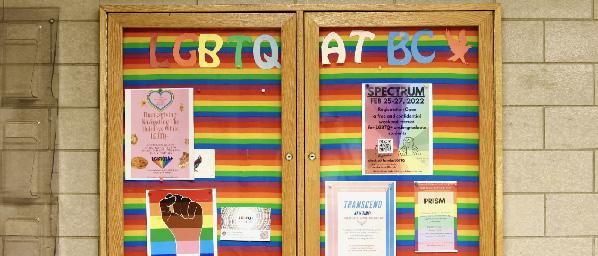

The Half Cookie, a small cookie and coffee shop in Chestnut Hill, has quickly racked up social media fame since its opening last June.


This Week’s Top 3 Events
Explore disabled students’ experiences at Boston College and how to foster inclusive dialogue in classrooms at an event co-hosted by the Council for Students with Disabilities and the Center for Teaching Excellence. Attend the panel on Tuesday at 3:30 p.m. in O’Neill 250.
Listen to author Kimberly Heckler discuss her book A Woman of Firsts: Margaret Heckler, Political Trailblazer, unpacking Heckler’s journey from being the only woman in her BC Law School class to serving in Congress. The event will be Tuesday at 5 p.m. in Burns Library.
1 2 3
Get ready for Marathon Monday and make a sign to cheer on your favorite runners or Saweetie. There will also be pizza, mocktails, and trivia to enjoy while you explore your creativity. Take
By
Boston College Law School and the Lynch School of Education and Human Development (LSEHD) each rose three spots in U.S. News & World Report’s 2025 graduate school rankings, climbing to No. 25 and No. 20, respectively.
The Connell School of Nursing (CSON) Doctor of Nursing Practice program surged 12 places to No. 14, while the Carroll School of Management (CSOM) full-time MBA held steady at No. 46.
“While no single ranking will ever capture the vibrancy and quality of our many degree programs, this year’s set of assessments underscores the powerful momentum that we’ve been building across Boston College’s nine schools and colleges,” Provost and Dean of Faculties David Quigley said in a University release.
According to U.S. News, rankings are based on a combination of expert opinions on program caliber and statistical indicators measuring the quality of a school’s faculty, students, and research.
After an eight-place drop in the 2022–2023 U.S. News law school rankings, this year marks
the third consecutive rise in BC Law’s ranking.
Several LSEHD specialty programs ranked in the top 20, with student counseling at No. 9, curriculum and instruction at No. 13, elementary education at No. 16, and both educational psychology and education policy at No. 20.
In the nursing specialties rankings, CSON’s Master of Science in Nursing program moved up eight places to No. 26, and its nurse anesthesia program also came in at No. 26.
BC Law also earned high marks in multiple specialty areas, ranking No. 12 in tax law, No. 18 in “Law Schools with the Most Grads at Big Law Firms,” No. 29 in international law, No. 31 in intellectual property law, and No. 34 in health care law.
CSOM’s part-time MBA program rose six spots to No. 17. In the business specialty rankings, both accounting and finance placed No. 9, marketing placed No. 12, business analytics placed No. 13, and management placed No. 37.
Several graduate programs in the Morrissey College of Arts and Sciences cracked the top 50 programs in the country, including economics (No. 29), sociology (No. 42), English (No.44), and history
(No. 47). The Clough School of Theology and Ministry and the MCAS theology department also received international recognition. The two programs jointly ranked No. 13 among world universities in the QS World University Rankings by
Subject for theology, divinity, and religious studies.
U.S. News ranks social work schools every four years, according to the release. In 2024, the BC School of Social Work was ranked No. 8 overall, making it BC’s highest-ranked graduate program.
Quigley said this year’s improvements are a reflection of BC’s continued investment in academics.
“I am pleased to see this growing recognition of our excellent faculty and programs by peers at the nation’s great universities,” Quigley said in the release. n
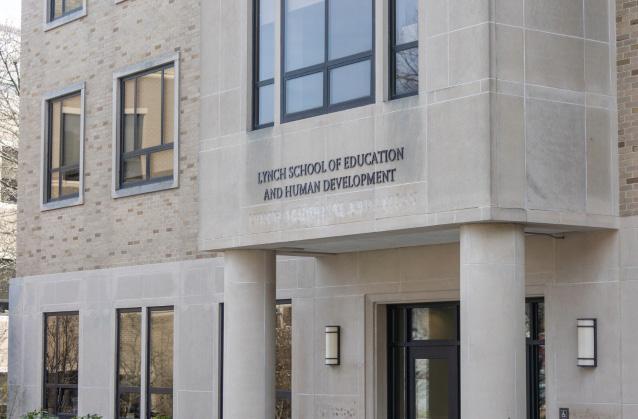
By NikiTa Osadchiy Asst. News Editor
Dame Louise Richardson, president of the Carnegie Corporation of New York, will deliver Boston College’s 2025 commencement address on May 19, the University announced.
“Richardson became the first female president of Carnegie Corporation of New York in January 2023, assuming leadership of a foundation— founded by industrialist Andrew Carnegie in 1911—renowned for establishing and endowing initiatives such as the United States National Research Council, National Bureau of Economic Research, and Children’s Television Workshop,” the University release reads.
At the ceremony, University President Rev. William P. Leahy, S.J., will present Richardson with an honorary degree, according to the release.
A first-generation college graduate, Richardson earned her PhD in
political science from Harvard University and served as vice-chancellor of the University of Oxford from 2016 to 2022.
Richardson has devoted much of her career to the study of international terrorism and foreign policy. During her tenure at Oxford, she was widely praised for her advocacy for minority rights and expanding access to higher education.
“For more than three decades, she has researched and written about international terrorism and foreign policy, advocating interdisciplinary approaches to study the political roots of extremism as an alternative to military-led responses,” the release reads. “At Oxford, she was lauded for defending freedom of speech, pursuing sustainability, and advancing racial equality.”
In January 2023, Richardson was named the first female president of the Carnegie Corporation of New York.
In her remarks as incoming presi-
dent, she emphasized the importance of expanding philanthropy during a time of democratic fragility.
“It is a great privilege and an even greater responsibility for us today to use Andrew Carnegie’s wealth wisely
to achieve the immutable objective of improving the world around us,” she wrote.
In addition to Richardson, the University will award honorary degrees to Geoffrey Canada, an educator and
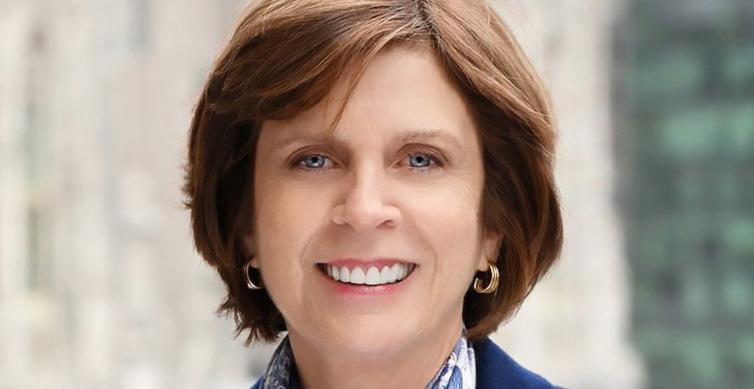
“As The Heights knows, Vice President for Student Affairs Shawna Cooper Whitehead has articulated her vision that the BAIC should serve all BC students, including members of our LGBTQ community, and she has added additional staff in support of their needs,” Dunn wrote. “Fr. Butler’s comment in The Gavel interview is consistent with that vision and reflects the position of most Jesuit, Catholic institutions.”
Under the leadership of University President Rev. William P. Leahy, S.J., the administration has consistently rejected calls for a standalone LGBTQ+ center.
For decades, members of the Boston College community have advocated for a dedicated LGBTQ+ space, separate from those serving other marginalized groups.
Butler reiterated the University’s commitment to dignity, inclusion, and acceptance, rooted in its Jesuit and Catholic identity.
“All people are made in the im-

age and likeness of God and deserve the inherent dignity that should be given because of that fact,” Butler wrote in a statement to The Heights “I believe that with my whole heart. Because of our Judeo Christian heritage, we are a community of welcome and acceptance within the commitment we have of being Jesuit and Catholic.”
Queer Leadership Council (QLC) Director Sydney Brown, MCAS ’25 expressed disappointment at Butler’s remarks.
“Hearing Father Butler say he doesn’t see Boston College having an LGBTQ+ Resource Center is incredibly disappointing, especially since LGBTQ+ students at BC have experienced increased hatred and hostility on campus in light of the evolving political climate, and we need and deserve visible support from our university now more than ever,” Brown wrote in a statement to The Heights
The conversation around a dedicated LGBTQ+ space gained renewed attention during this year’s UGBC presidential campaign.
Jack Adams, MCAS ’26, one of three candidates vying for the presidency, reiterated his campaign promise to allocate part of UGBC’s budget to converting part
of UGBC’s office into an LGBTQ+ resource center during the presidential debate.
“We’re not going to give up on the fight for the LGBTQ resource center,” Adams said during the debate. “We intend to spend part of our budget on hiring peer counselors and graduate assistants to actually assist LGBTQ+ students.”
Cami Kulbieda, LSEHD ’26, who was elected UGBC president, acknowledged the persistent roadblocks students have faced in creating a dedicated LGBTQ+ resource center.
“I’ll emphasize Andrew’s point that an LGBTQ+ resource center has been a tried-and-tried initiative for over 20 years,” Kulbieda said during the debate.
“Only in the last three years—less than that—has the BAIC even accepted LGBT resource centers.”
In spite of the decades of rejection, Brown holds out hope for future change.
“It’s not surprising to me, nor to many of the current and former members of QLC who have pushed for a resource center for years, to be met with repeated rejection,” Brown wrote. “I sincerely hope that sentiment changes moving forward.” n
By ReeTu AgnihoTRi Asst. News Editor
Many Boston College professors have adopted policies prohibiting students from using generative AI tools like ChatGPT for essays and assignments.
Although AI detection software like GPTZero reports being able to detect AI-generated content with up to 99 percent accuracy, the AI Steering Committee plans to discourage professors from using it to track generative AI in students’ work, according to Cristina Gregory, student senator and MCAS ’26.
“They’re looking into ways where we can motivate professors to not use this software,” Gregory said. “Even if they think that students are using AI, it’s hard to make one standardized procedure because we leave a lot up to the discretion of professors and definitely have a lot of control for their classes.”
During the UGBC Senate meeting Tuesday night, student senators discussed whether Boston College should continue investing in the generative AI tools it provides—such as Microsoft Copilot, Gemini, and NotebookLM—because students tend to prefer ChatGPT.
“They’re putting a lot of time and energy into getting and using these resources, and they’re not seeing students use them,” Gregory said. “So, they don’t know if they should put their weight behind ChatGPT.”
Gregory said the committee
wants students to utilize its generative AI tools like Copilot instead of ChatGPT, citing privacy and data safety concerns. The committee also believes these tools are more effective for tasks like coding or checking spelling and grammar, Gregory added.
“If we cultivate productive ways to use ChatGPT and pub that out to students, rather than trying to shut it down completely and students just end up using it to write full essays, I think that’d be a more productive route,” said Mariame Diop, student senator and MCAS ’27.
According to Gregory, the committee is aware that students primarily use ChatGPT and is open to supporting students in using it responsibly. Still, she emphasized that the committee encourages students to explore the generative AI tools the University offers.
But Aidan Krush, student senator and CSOM ’27, said ChatGPT is more versatile and streamlined than other AI tools, arguing that the committee should focus on encouraging ethical use of ChatGPT rather than promoting multiple platforms.
“If you have eight different AI platforms, and this one does citations and this one does this other thing, ChatGPT can do all of that, and it’s just more mainstream,” Krush said. “I would be an advocate for having responsible use of ChatGPT over trying to implement like 10 different AI services.”
No other generative AI tools match the extensive data that
ChatGPT accumulates over time, according to Katie McCaffrey, student senator and MCAS ’25.
“You spend so much time putting your data into your ChatGPT, it knows what you want, so expecting students to switch over to a different platform is not beneficial because they’re always going to prefer ChatGPT,” McCaffrey said.
McCaffrey said ChatGPT also encourages responsible use because students have to learn which prompts produce the answers they are looking for.
“There are great ways for it to help you write, but it needs to be
with responsible prompts, like in sections or helping with grammar,” McCaffrey said. “I think that’s so much more beneficial than essentially trying to get students to use platforms that, in reality, they’re not going to want to use.”
Student senators then discussed the discrepancies between the paid and free versions of generative AI tools. According to Gregory, the University provides students access to premium versions of its approved tools to level the playing field for students who might not otherwise be able to afford them.
“They picked ones that they
thought were either the best at very specific tasks or could allow everyone to have complete access to an extended version,” Gregory said. “They don’t want some students to have access to the regular ChatGPT and then others to be able to pay for the higher end because that could cause discrepancies in classes and work submitted.”
Gregory said she plans to ask the committee to consider providing students with paid ChatGPT subscriptions.
“A good next step might be to look more into ChatGPT, if it’s even an option.” Gregory said n
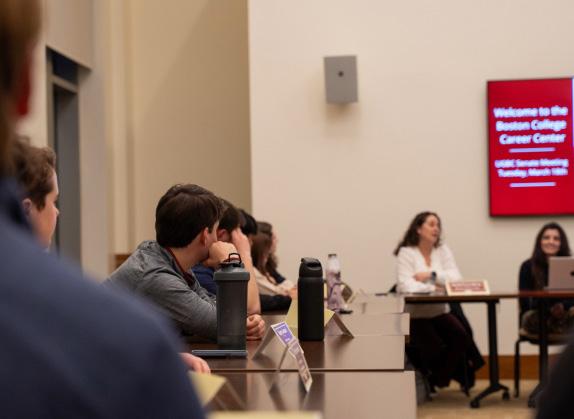
UGBC discussed the University’s AI tools and the discrepencies between different AI platforms.
On the evening of March 20, Mary Connors, MCAS ’26, and two of her roommates returned to their off-campus Brighton home after dinner to find signs of a possible break-in.
“I noticed on the ground, there was so much dirt all over my white carpet, and then dirt, not just in my room, but also leading into the hallways,” Connors described. “I texted my roommates, and I was like, ‘Guys, did somebody go into my room? Just wondering, because my shades are weird and there’s dirt all over.’”
After her roommates also found dirt in their rooms, Connors went to check her valuables, fearing someone had entered the home.
“I have a little dish on my desk with all of my jewelry—costume
jewelry, nice jewelry, family heirlooms—and they were all completely gone,” she said. “My roommate also had all of her jewelry gone too.”
“I
noticed on
had stayed home that night. Connors believes her roommate may have startled the intruder before they entered her room.
women living alone—but ultimately, they weren’t able to do much,” said Connors.
In the weeks following the incident, Connors said she and her roommates have taken additional precautions, including installing window bars.
location of several recent break-ins involving a possible suspect description as a male/unknown race, wearing all black/dark clothing, gloves and a ski mask,” the report reads.
dirt
the ground, there was so much
all over my white carpet, and then dirt, not just in my room, but also leading into the hallways.”
One of Connors’ roommates
“We think he never came into her room,” Connors said. “We think that as he was heading that way—since the trail of dirt stops just before her door—she turned on her blow dryer to dry her hair, and that made him leave. “
According to the police report, up to $10,000 worth of jewelry was stolen. Surveillance footage from a Ring camera captured the suspect pacing in the side yard before entering through a locked window.
Connors said she was grateful for BCPD’s response and the sense of reassurance they provided, even if there was little they could do after the fact.
“BCPD showed up first, and honestly, they were great and very helpful—just made us feel safe as
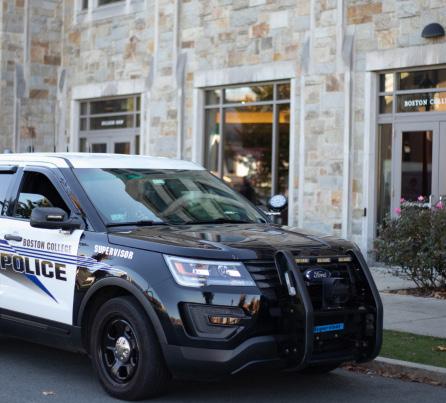
Despite the fear and uncertainty, Connors expressed appreciation for the support they received from BC.
“The dean of off-campus housing came to our unit and treated us and the boys upstairs to dinner from Jersey Mike’s,” Connors said. “He sat with us, talked about what happened, and went over safety precautions we can take, so that was really nice. He went out of his way to do that on a Thursday night, which we really appreciated. It’s just really nice how the Boston College community has supported things that are out of their control.”
“BCPD showed up first, and, hon-
estly, they were great and very helpful—just made us feel safe as women living alone—but ultimately, they weren’t able to do much.”
In the most recent incident on April 3, BPD responded to a call about a suspicious individual near the scene of the earlier break-ins. The man matched the description of the alleged suspect—a male of unknown race, dressed in all black, gloves, and a ski mask, according to the police report.
“This specific area is a known
BC students reported seeing the individual standing in the yard of a home on Radnor Road, appearing to scout it out. The students attempted to contain him and alerted nearby BCPD officers to his location.
“He went out of his way to do that on a Thursday night, which we really appreciated. It’s just really nice how the Boston College community has supported things that are out of their control.”
“The students reported that the male attempted to flee through a backyard and struggled to make escape, before running towards the students and fleeing down Radnor Rd,” the report states.
In its advisory, BPD urged residents to take preventive measures and to remain vigilant.
“We urge all community members to remain alert and take simple but effective steps to protect their homes and belongings: Always lock doors and windows, even when at home; Install motion-activated lighting around entryways; Consider home security systems or video surveillance; Avoid leaving valuables near windows or in plain sight,” the advisory urged. “If you observe any suspicious individuals or activity in your area, please call 911 immediately. Quick reporting allows officers to respond faster and may prevent further crimes.” n
By Mei DasgupTa Editorial Assistant
In an era of rapid change in higher education, University President Rev. William P. Leahy, S.J., believes Jesuit schools can evolve while staying grounded in what has worked for almost 500 years—preparing students to make a lasting, tangible impact on the world.
“The genius of Ignatius was to combine study of the humanities with character formation,” Leahy said. “Jesuit education is apostolic. We’re trying to shape the world, influence the world through students.”
Leahy spoke at a panel on Wednesday alongside Christiano Casalini, endowed chair of Jesuit pedagogy and educational history and research scholar at the Institute for Advanced Jesuit Studies. The panel, moderated by Elizabeth Shlala, associate dean for the core, was sponsored by the Church in the 21st Century and explored Jesuit education and its foundations.
Casalini opened the talk with a look into the origins of Jesuit education, highlighting its roots in the lived experience of students.
“Education was important for the early Jesuits from the very beginning, at least because they were all students at [a] university,” Casalini said. “They were students at the University of Paris—that’s where St. Ignatius of Loyola met his fellow students.”
Casalini emphasized the im -
portance of community, especially through residential life, in shaping the Jesuit approach.
“They found [each other] in that space, which is something that tells [you about how important residential life is still today], for the experience of a student,” Casalini said. “You share lives together, and not only among students, but also with faculty.”
Casalini also traced how early Jesuit education experiences contributed to the development of Jesuit pedagogy.
“They had games and sports in the courtyard,” Casalini said. “These were aspects that were important to the development of the Jesuit pedagogy … where the Jesuits themselves could be at the forefront of the encounter with students.”
This mission, Casalini explained, grounds Jesuit education and has kept it relevant for centuries.
“What marks the continuity of Jesuit thinking on education throughout the century is this strong belief in the transformative power of education, in the social power of education,” Casalini said.
Leahy reflected on how Jesuit education emerged from the culture of the 16th century, which placed a lot of emphasis on classical education, including the study of languages and philosophy.
Leahy noted that mission took tangible shape in the American context, specifically in the growth of Catholic immigrant communities.
“The mass of Jesuit schools
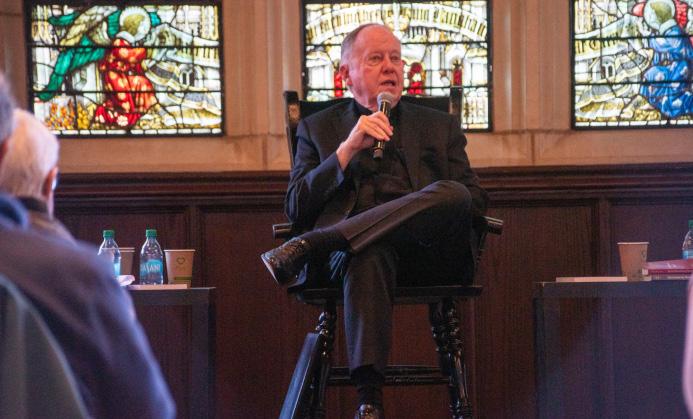
came out of the need and desire to help an immigrant church develop a more learned lay community,” Leahy said. “And so we started our schools where there were sizable populations of Catholics, and most of those were immigrants.”
Leahy also drew on the importance of mission to guide BC as a Jesuit institution and root its values and decisions.
“Jesuits started schools because they saw it as a way of not only helping individuals develop their talents, but also to use those talents for the good of others, and so mission is just critical,” Leahy said.
Reflecting on BC’s growth since
its founding, Leahy noted how it has evolved in response to changing times.
“One of the aspects of Jesuit education is to adapt, and there are changing times,” he said. “BC has changed its mission, in 1864 [it] was focused on Boston—now it’s the world.”
Leahy identified that the ability to evolve while staying grounded in mission has been a hallmark of Jesuit institutions.
“Mission could change, it’s not locked in,” Leahy said. “If you are really going to be effective, I think you have to be able to evolve.”
Amid today’s complex political and cultural landscape, Leahy stressed the need for Jesuit universities to be both reflective and responsive.
“If you think of what’s going on in our country today, with federal interventions [and] executive orders—we have to adapt to changing circumstances,” Leahy said. “We have to know who we are.”
Leahy closed by emphasizing universities’ roles as dynamic spaces for cultural exchange and collective growth.
“A university is a great repository of culture, and it can spread the mission, the knowledge, the heritage,” Leahy said. “And a university brings together people from different backgrounds, and they influence one another.”n
By aMelia alexoupolos Heights Staff
Boston College head football coach Bill O’Brien took a break from recruiting and drawing up plays to speak to a packed audience in Hillside Cafe about the foundations of his faith.
“I wouldn’t say it was a strict Catholic house, but it was very faithbased,” O’Brien said. “My parents raised us to have a strong belief in family—how important it was to be loyal to your family, to understand the history of your family. They raised us to understand the value of education, and they raised us to understand the value of hard work and what that meant in your life.”
O’Brien spoke Tuesday evening as part of the Agape Latte series, a faith-based storytelling program sponsored by the Church in the
21st Century Center and Campus Ministry.
He began by telling the story of his life, focusing on his education, career, and family. He described a pivotal moment in his spiritual life from high school while attending St. John’s Preparatory School in Danvers, Mass.
O’Brien explained how St John’s football chaplain, Rev. Tony Penna, cemented the importance of faith for him during a eulogy Penna delivered at a funeral for one of O’Brien’s high school classmates.
“I remember listening to Fr. Tony and how Fr. Tony described this young guy’s life, and how important it was to understand than the faith that you have when tragedy hits—when things happen in your life that are just absolutely terrible— that your faith in God is essential,” O’Brien said.
O’Brien then shared a personal story about the birth of his son, Jack, who was born with lissencephaly, a rare genetic condition that affects brain development.
“We had a doctor that told us this kid won’t live past two, and I don’t know where that doctor is now, but Jack will be 24 in August,” O’Brien said.
O’Brien explained how his son’s story serves as a reminder that life is unpredictable.
“Jack requires 24/7 care, mostly provided by my wife and some nurses that help us out, but I think that’s just an incredible story, relative mostly to my wife, of faith in God, of understanding that your life will take you on different twists and different turns,” O’Brien said. “Things in your life will most of the time be good, but I tell the guys at Boston College all the time, I tell the football team
all the time, it’s really how you deal with adversity because life is about adversity.”
O’Brien spoke of the career changes he has made, and his transition to coaching at BC.
“One of the greatest things that I do right now since I arrived here on campus is that I go to Mass on Upper Campus,” O’Brien said. “And for me, that’s the time of the week where it kind of re-centers me.”
O’Brien responded to a question regarding his approach to prayer, saying how he used to pray for wins but now prays for the health of his team.
“I used to say, ‘Please God let us win,’” O’Brien said. “I don’t think God really cares about football—although, I don’t know, when we play Notre Dame, I think he’s on our side—but I do pray for the health of the team, the success of the team, to
play well, win or lose, in a manner that represents peace in the right way.”
O’Brien added that he often prays to his son.
“I think about my son a lot,” O’Brien said. “My son has a calming influence on me, so I pray to him. I look at him as an angel on Earth.” Throughout the talk, O’Brien discussed the connection between his coaching style and his faith, explaining that it gives him confidence when facing difficult situations.
“I think, in the end, [the key is] a consistent approach to life,” O’Brien said. “It’s what I talk to our guys about all the time. Having a consistent approach to life allows you to deal with these things in a manner where you can say, ‘You know what, I’m gonna come out on the right end of this,’ and I think having faith in God is a big part of that.”n
By MaDison hoang Heights Staff
Non-citizen activists in the United States face increasing legal uncertainties when exercising their right to free speech, especially under the Trump administration, according to Mary Holper, director of the Immigration Clinic and a clinical professor at Boston College Law School.
“’How are you supposed to know what you can and can’t do?’” Holper said. “When Rümeysa Öztürk wrote an op-ed in the Tufts newspaper last year, how was she supposed to know that it would cause the secretary of state to believe that it would have serious foreign policy consequences here in the United States?”
Holper spoke Thursday afternoon at an event hosted by BC Law School, in partnership with the National Lawyers Guild at BC and the South Asian Law Students Association. Her talk focused on the intersection of immigration law
and First Amendment rights, particularly in cases where non-citizen activists have faced legal repercussions for their political expression.
She cited recent examples— including Mahmoud Khalil and Jeanette Vizguerra, who were detained and threatened with deportation due to their political speech—and explained how jurisdictional maneuvering is often used to undermine due process for non-citizen activists.
“The strategy is to move someone to Louisiana, so that there will be an unfriendly venue in the district court in Louisiana,” Holper said. “If they get shipped off to Louisiana and have to file there, then that means the government is more likely to win.”
According to Holper, certain legal provisions allow for the deportation of non-citizens if the secretary of state deems their activities harmful to U.S. foreign policy interests. She said the provision’s vagueness is framed as a constitutional paradox, leaving
non-citizens unsure whether their speech might result in deportation.
“This is a problem in the law, called a statute that is voidfor-vagueness,” Holper said. “The grounds of deportation are deliberately vague. It’s whatever the secretary of state decides is a compelling foreign policy interest, which of course, can change.”
This is ironic, as President Donald Trump’s sister, Maryanne Trump Barry, had previously ruled that this provision was unconstitutional during her tenure as a district court judge, according to Holper.
“The sibling rivalry must be amazing,” Holper said. “Trump creates this fabulous ground of deportability, and yet his sister says from the grave, ‘No, that’s unconstitutional, you can’t do that.’”
Beyond the legal implications, Holper highlighted how these cases create a silencing effect beyond the courtroom, preventing victims from exercising free speech.
Holper shared the story of
one of her immigration clients who wanted to criticize the Internal Revenue Service’s policies that allowed the sharing of taxpayer addresses with immigration authorities but ultimately chose to stay silent for fear of potential retaliation from immigration authorities.
Holper advised others to carefully consider their situation before speaking out.
“Don’t speak unless you’re willing to risk what these activists have risked,” Holper said. “No one wants to be sent to a jail in Louisiana—the conditions there are horrible. Take down all your social media posts, have a burner phone when you travel in and out of the country, because the consequences are what we saw happening to Rümeysa Öztürk.”
Despite these challenges, Holper expressed hope in the growing public opposition to these deportation cases. She referenced attending a recent protest on Boston Common, where demonstra -
tors held signs reading, “We Still Have Free Speech Rights.”
Holper noted that questions surrounding free speech rights for non-citizens are actively being discussed in academic circles as well.
“An immigration law professor at [the University of Nevada, Las Vegas] responded to someone who said, ‘You have no First Amendment rights if you’re not a citizen,’ Holper said. “He joked, ‘OK, I guess I’ll have to post my birth certificate before writing a blog post.’ Everyone has free speech rights, but for non-citizens, the consequences are just so hard right now.”
Reflecting on the broader implications of these social challenges and legal strategies, Holper said ultimately, the government often wins either way.
“They have accomplished the suppression of speech by making people afraid to speak,” Holper said. “That’s pretty much the reality that we’re in right now.” n
B y R iley D el S e S to Asst. Newton Editor
A line of people snaked around the sidewalk on The Street at Chestnut Hill Saturday morning, all waiting for their turn to enter a tiny storefront next to Star Market with the silhouette of a bitten cookie on its glass door.
Every weekend for the past two months, a crowd has gathered to taste The Half Cookie, a small cookie and coffee shop in Chestnut Hill. Since its opening last June, the store has quickly racked up social media fame, garnering viral reviews on TikTok—some with as many as 50,000 likes.
According to Danielle Velez, the store’s owner, online publicity has been instrumental to The Half Cookie’s success.
“It’s really cool, just to see what self-generated social media can do for a company, because we’ve never paid for marketing or anything,” Velez said. “So as a small business, it’s such a game changer for us and our team.”
Velez started The Half Cookie in 2021 through a series of popups in the Seaport area and online orders after cookie-brainstorming sessions in her kitchen.
“This is something that I started from my kitchen,” Velez said. Velez explained that the popups gained considerable social media support in the beginning, but it was nothing compared to the extent of the store’s current social media buzz.
“We’ve always had a pretty strong social media presence,” Velez said. “It’s been crazy. I thought that we had experienced viral moments before, but it was nothing to this caliber.”
The Half Cookie made the switch from pop-ups to retail in 2024 through the Seaport’s incubator shops—spaces for businesses to experience retail for three months—before moving to The Street. The store’s Chestnut Hill location was originally supposed to last for only 10 months, but The Half Cookie recently extended its
lease for another year and a half, according to Velez.
“For us, as a small business, it’s a really nice way to kind of dip our toe into a retail space because we’ve started from the ground up,” Velez said. “We don’t have any investors or anything like that. So we obviously want to take risks, but we don’t have any money to build off of except what we’re generating on our own.”
The Half Cookie’s background in pop-ups inspires the slogan on its website, proclaiming that “The Half Cookie is more than just a cookie. It’s a Boston experience.”
“I feel like our business grew from the relationships with other small businesses and entrepreneurs that I’ve met,” Velez said. “People in Boston, I feel like this area, they really do try to support local businesses.”
Velez said she also received lots of support from local, women-owned businesses.
“I’ve met so many other wonderful female entrepreneurs that we’ve learned from each other, and I feel like we kind of created this small-business community,” Velez said.
Employee Matt Kern said he is proud to be part of a female-owned business.
“I think knowing that it is a woman-led business makes me feel like I’m really part of something special,” Kern said.
While “The Half Cookie” wasn’t Velez’s first choice for the name of her cookie store, it felt relevant to the cookies’ place in her life at the time.
“When I went to get a website domain, one of the … names that I had was already taken,” Velez said. “When I first got started, I had just had my first daughter, Audrey … She would fall asleep on me, so I would be stuck there for hours, and I made like a huge cookie. So we would joke that I would eat half in the morning and then half in the afternoon.”
The name speaks to the size of the cookie and its impact: a sweet treat that motivates you through an
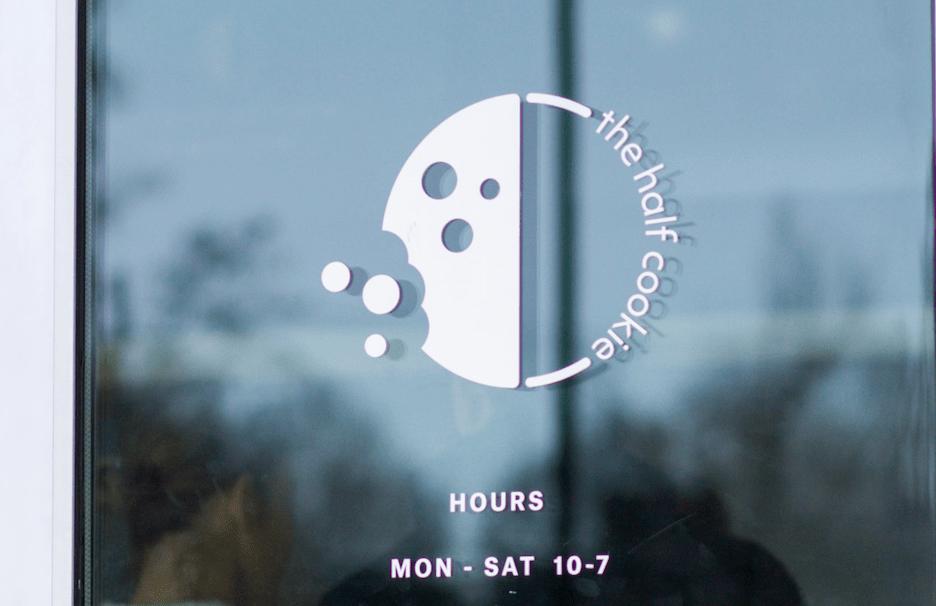
entire day. Additionally, the name
“The Half Cookie” left room for Velez and her husband, who was very active in the store’s evolution, to explore other treats within the store.
“We always knew that we wanted to do more than just cookies—like we love coffee,” Velez said. “The Half Cookie is kind of meant to be like, whatever that other half is that we want to grow into … Right now, coffee has been a really big part of our business as we expand.”
While customers mostly come to The Half Cookie for their cookies, Madison McCall, MCAS ’27, Sydney Orland, MCAS ’27, and Abigail Shalgian, CSON ’27, said they come for the coffee.
“ The cookies are really good, but I think we mostly come for the coffee,” McCall said. “I like getting to switch it up with inventive flavors.”
The Half Cookie has a consistent cookie menu of five base flavors and five seasonal flavors, which change monthly. This variation in cookie flavors is a model other trendy cookie shops use, like popular cookie chain Crumbl Cookies, which switches its flavors weekly.
The Half Cookie’s current base

flavors are brookie, sea salt nutella, salted Twix, chocolate chip, and Funfetti, while its seasonal flavors are mini Cadbury, peanut butter, Butterfinger, Dubai chocolate, and Lucky Charms, according to Kern.
“So we try to have [our flavors] be around any holidays that are coming up or seasonal flavors that are really popular,” Velez said.
Customers enjoy seasonal flavors so much that The Half Cookie decided to have “flavor battle” polls on Instagram to decide which flavors to release from “the vault.”
“We always try to get feedback from people,” Velez said.
With a line forming every weekend, customers usually wait 30 minutes to an hour to get into the store, starting from when it opens at 10 a.m. until around 4 p.m., according to Velez.
So while McCall, Orland, and Shalgian waited in a long line one Sunday, Velez rewarded the customers’ endurance with a cookie appetizer.
“They’re so nice,” Shalgian said. “ We [were] in line on Sunday—and a really long line—and they brought out free mini cookies for everyone that was waiting.”
According to Kern, though the store closes at 7 p.m., The Half Cookie sells out of all their cookies at around 5 p.m. every day. Velez stressed that she only has a team of four employees, most of whom have full-time jobs. The rise in Half Cookie fame happened so fast that it was hard for her and her team to keep up.
“From January to February, we doubled our sales, and then we doubled it again from February to March,” Velez said. “So right now, we’re operating with the same team, but doing like, four times the amount of everything. … We never expected to do this kind of volume.”
Employees prep 500 to 1,000 cookies each day, and the process behind each cookie is intricate and requires multiple steps.
The dough sits for 24 hours in order to chill and marinate in its flavor in The Half Cookie’s production kitchen in Winthrop before being transported at 5 a.m. from Winthrop to Chestnut Hill by either Velez or her husband. The Half Cookie’s store on The Street is only 400 square feet, including the bathroom. It contains no kitchen, just a walk-in fridge to store the dough.
“So really, we’re operating out of, like, a 200-square-foot space, which is just a lot [to manage], which I think explains the lines on the weekend,” Velez said.
Velez hopes to expand her team, especially since she plans to open another store in Winthrop and hopes to set up an online delivery service for her store.
“We’re just kind of waiting to have the bandwidth to be able to roll that out,” Velez said. “We just need more hands on deck.”
Despite the hectic nature of running a buzzing small business, Velez said she is not willing to sacrifice The Half Cookie’s quality, a trait that makes its cookies stand out from competitors.
“One thing that [makes our cookies] really stand out is the quality of ingredients that we use, which is extremely hard nowadays with the prices of everything,” Velez said. “We just refuse to compromise on that.”
And for The Half Cookie’s employees, baking is a labor of love.
“Because we’re a small batch institution, we try to bake with the highest quality ingredients, and we put our heart and soul into it,” Kern said.
Velez said she is surprised and appreciative of The Half Cookie’s overwhelming success.
“This has all been very surreal to be honest,” Velez said. “I’m grateful to everybody. And, yeah, it’s just really exciting to see people care about your business. It feels really surreal. It’s like, the only word for it.” n
Tumors, from A1
The reported cases of brain tumors within the fifth-floor staff have been diagnosed over a several-year span, read the newly released statement by Ellen Moloney, president and chief operating officer of Newton-Wellesley.
The update explains that testing is being conducted by the Mass General Brigham Department of Occupational Health and Safety and a multidisciplinary group of experts.
“[Testing] has involved interviews of impacted staff, a thorough review of air and water quality,
and comprehensive testing for any potential radiation, chemical, or pharmaceutical exposures,” said the statement.
According to NBC10 , a representative told the news outlet that the sixth person came forward to doctors working on the investigation to disclose the previous diagnosis.
The representative noted that the diagnoses are self-reported, according to NBC10 The hospital remains firm that nothing within the fifth-floor working conditions has been identified as a cause for the tumors.
“Based on the results of this
rigorous ongoing investigation, we can assure you that no environmental risks have been identified at our hospital,” reads the letter. Maloney’s letter reiterated that
the hospital is prioritizing staff and patients’ well-being.
“As always, your health, wellbeing, and safety—along with that of our employees—remain our top
priority,” reads the letter. “While there has been a great deal of misinformation shared on social media and in other forums, we want to make sure you have the facts.” n

B y s ophia G allon
Heights Staff
Right down the road from Newton Centre Green sits a shop for bookworms and record lovers alike, transporting customers to a store reminiscent of one from the early 2000s with its striped awning and warm colored interior decorations. The store’s logo, a dog sitting sheepishly and turning its head to the left, appears as if it’s nodding toward passersby, inviting them to come inside and stay a while.
What started as a cab company became a makeshift bookstore operating out of owner Barry Tilles’ home. Years later, Tilles found the vacant building he needed to transform his love of collecting records and books into a successful business.
“It was like you had to put everything together,” Tilles said. “So it was, you know, a bit of luck and determination. Finding a place was the biggest thing.”
Tilles’ business currently occupies 1187 Centre St. next to many other bustling stores in Newton Centre’s quaint village.
The store’s walls are lined top to bottom with shelves, novels almost bursting out of each one. Ex-
ploring the store’s varied genres is almost like finding the way through a maze with an accompanied quirky theme song due to Tilles’ music choices flooding the shop.
While Tilles finds many of his books and records himself through used book sites or in-person sales, many people in the community come in to donate books to the store, which he feels creates a connection.
“We are connected in that the customer, the community, or the people, are also the ones who bring in the merchandise,” Tilles said. “It’s a two-way street.”
Ben Greenes, a loyal customer of Good Dog Records & Books, says it’s Tilles himself who keeps drawing him back into the store.
“Barry helped me catch a wave back into reading, with not a shred of pretense,” said Greenes.
Greenes also shared that Tilles’ extensive collection of books has him reading odd picks he wouldn’t have thought to read otherwise.
“Barry has a perpetually accumulating stack of everything you never knew you needed to read— and more,” Greenes said.
It doesn’t matter if Greenes goes into the shop with a specific
book or record in mind, Greenes said he always leaves with something.
“Even when I rarely leave without a book, I leave with a song I’ve never heard before, or I leave with a conversation [I] never expected, with someone I might never otherwise meet,” Greenes said.
Richard Martin Jarell, who goes by Wombat, shared the same opinions about Tilles and Good Dog in general.
Jarell explained that hanging out at Good Dog, even if he doesn’t end up leaving with any books or records, helps keep his vocabulary
fresh—something he struggles with due to his aphasia.
Jarell is a writer who tends to need very specific editions of plays and manuscripts. While Good Dog doesn’t always carry exactly what he needs, he still feels drawn to the store.
“You could have a conversation with Barry for hours, then add on the wanderers in and out of the store, and you’re there longer than you know,” Jarell said. “Time just happens to pass quickly in there.”
Jarell also highlighted the sense of community and friendly business relationships between
Good Dog and the new bookstore, Newtonville Books, located just across the street.
“They’re not [adversaries] to each other, which I think shows a genuine respect for each other,” Jarrell said. “I would even say they should put up posters of each other’s stores in their own [stores].” Tilles appreciates the community his store attracts, even if they keep him on his toes.
“We love the people, they’re great to have here,” Tilles said. “While it’s hard to sometimes keep up with their level of expertise, we love them.” n

By laney Mcaden Assoc. Newton Editor
Newton City Council met Monday to discuss two amended versions of Newton’s accessory dwelling unit (ADU) ordinance following extensive discussion by the Zoning and Planning Committee (ZAP) to bring the final version into accordance with the Affordable Homes Act.
Of the two proposed versions of the new ADU ordinance, neither went to a vote.
Ward 1 Councilor-at-Large John Oliver had the enhanced, amended version chartered, or held, until the council’s next meeting, and Ward 2 Councilor-at-Large Susan Albright followed suit with the second, state-compliant version.
The amended plan was the subject of the previous eight ZAP meetings, according to ZAP chair and Ward 7 Councilor Lisle Baker.
ZAP previously voted 5–1, with two abstentions, to approve a new ordinance compliant with the new state Affordable Homes Act.
Beyond the state-mandated ordinances, ZAP chose to add further Newton-specific amendments, including a proposal by Albright that increases by-right size allowances for ADUs and increases the ability to create ADUs in pre-existing homes.
ZAP also approved an option without the additional amendments that was put to a vote before the city council.
Baker explained the importance of being thorough and transparent when it comes to ADUs, as they can potentially impact all residents at some point.
“I think it’s important that we show these to the public, because, as opposed to, for example, the MBTA ordinance, which affected a significant minority of the city, this affects virtually all the residential
opportunities in the city,” said Baker. “It’s important we understand what’s going on.”
Following Baker’s overview of the added amendments, several councilors came forward to explain their support for approving the ordinance as is.
“I don’t think we need to send this back to the committee,” said Albright. “I think the folks in the committee had their points of view, and I don’t know that they’re going to be changing by sending it back.”
Albright, who serves on ZAP, previously abstained from sending the ordinances to city council, but she explained that she believes it’s important to get the ordinance to move forward.
“So even though it has things in it that I wasn’t happy with, I was going to vote for it,” said Albirght. “I hope that we will pass this tonight, in the hopes that maybe we’ll get a few more ADUs to add to the 121
Newton’s had in the last 40 years.”
War 6 Councilor-at-Large Vicki Danberg agreed with Albright, explaining that she believes the ordinance to be as ready as possible for implementation in the city.
“We have cooked this,” said Danberg. “We’ve had eight meetings on this. This is done, and we’re ready to stick a fork in it.”
Several councilors were unconvinced of the first version’s readiness, particularly regarding the Newton-specific amendments. Ward 5 Councilor-at-Large Rena Getz Escudero expressed her disagreement with Danberg’s sentiments.
“We spent a considerable amount of time on this, and I appreciate everybody’s suggestion that it’s fully baked, but it’s not,” said Getz Escudero.
Oliver explained that he does not believe the additional amendments have been fully understood, specifically in terms of possible
loopholes that might still be present in the fine print.
“I received a handful of questions from people in this room as well as other constituents,” said Oliver. “I couldn’t answer the questions that I was receiving.”
Acknowledging that several council members were clearly opposed to sending the ordinance back to ZAP, Oliver chose to charter the first item.
“If we don’t want to send it back to committee, there’s only one other thing I can do here,” said Oliver. “I’ll charter the item, and I’ll get the questions answered myself.”
Feeling as though the two separate ordinance options should be discussed together, Albright then chartered the second item, which simply held amendments for state compliance.
The two items will be up for discussion at the next city council meeting, April 22. n
By Genevieve Morrison Newton Editor
On Monday night, Newton’s Planning and Development Board passed the city’s Annual Action Plan, a federally mandated report describing how the city will spend its more than $3.5 million in federal housing grants in the coming year.
Newton receives three grants: the Community Development Block Grant, used for community infrastructure or public services; the HOME Investment Partnerships Program, used for bolstering affordable housing; and the Emergency Solutions Grant, which helps people regain housing after homelessness.
The greatest of these grants is the $1.86 million Community Development Block Grant. Sixty percent, or $1.1 million, of this grant will go to creating and supporting affordable housing infrastructure.
This will contribute to projects like redeveloping the West Newton Armory site on Washington Street entirely into affordable housing, which is set to open next year.
“We are hopefully just a week or two away from the financial closing on this project, after which they’re hoping to start almost immediately under construction and have the project open in FY27,” said Laura Kritzer, Newton’s director of housing and community development.
Newton will also spend a portion of this grant money on three $10,000 direct subsidies to individual low-income homebuyers in Newton.
Newton will allocate 15 percent of the grant to supporting human services, including programs at 15 local organizations, such as Newton Food Pantry, the John M. Barry Boys & Girls Club of Newton, and Riverside Community Care.
According to Nika Sandal, a Newton community development planner, the city’s priorities in allocating this funding were to “directly provide stability across the lifespan” for Newton’s low-to-moderate income population through a track
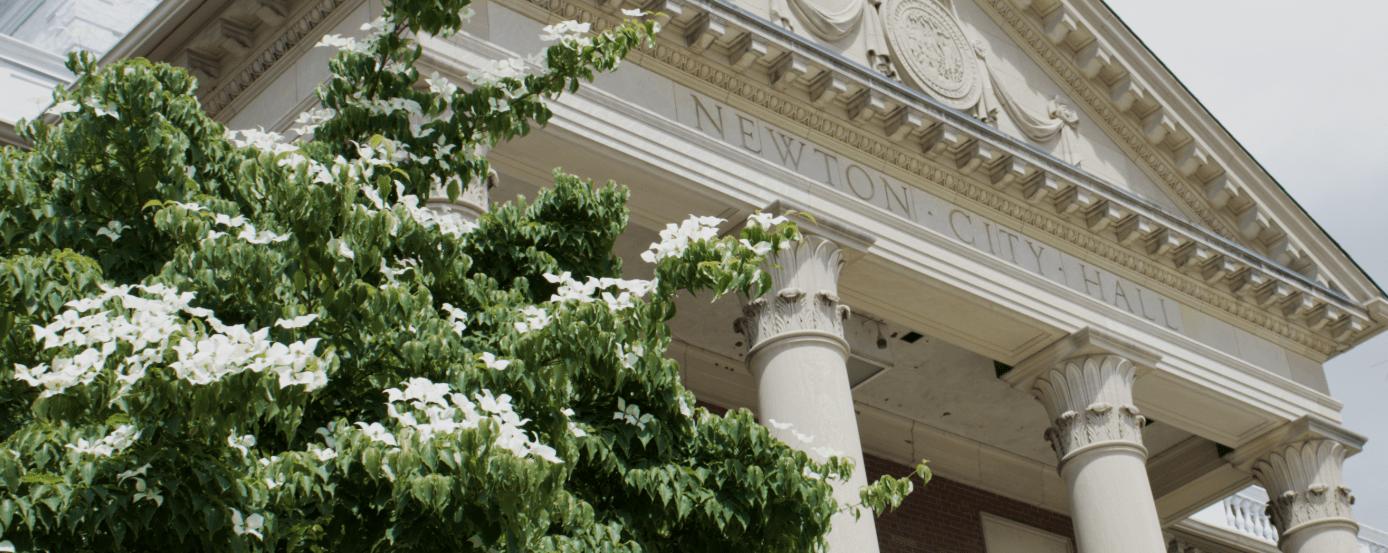
program that supports individuals successively from youth to adulthood to old age.
The second grant is for the Home Investment Partnership Program, for which Newton acts as an intermediary, distributing predetermined federal grants both to the city and the 12 other member communities in the MetroWest area through a body called the MetroWest HOME Consortium.
“Newton is fortunate in many ways that we’re the lead [of the] Consortium for those funds, which means we’re the convener of the consortium communities, and we do a lot of work in that respect,” said Barney Heath, director of planning and development.
In total, the Consortium will receive $1,526,678, which will be spent on rental assistance for housing, renovating current affordable units, and building new units across the MetroWest area. This will include funding developments like the Eliot Street project in Natick, which will transform a former public school into 32 affordable housing units.
“The money is put to very good use in all of the communities, as you can see,” Heath said.
Of the third federal grant, the Emergency Solutions Grant, 46.6
percent will be spent supporting local homeless shelters through building maintenance and renovations.
An additional 23.3 percent of the grant will go to rent assistance and moving costs for homeless or housing-insecure individuals and families, while 22.6 percent will be spent moving families into permanent housing.
Community Day Center of Waltham and Brookline Community Mental Health Center will be the two recipients of this funding.
Following the Annual Action Plan’s approval in Planning and Development on Monday, the city’s Zoning and Planning Committee and Mayor Ruthanne Fuller will have to approve the document before it’s submitted to the U.S. Department of Housing and Urban Development. When asked what the city could do to support further affordable housing efforts, Kritzer commended the 2023 village center zoning legislation that upzoned many parts of Newton.
“I think the more you can support and help projects move forward that provide more affordable housing, hopefully, in the end, we end up with more, and kind of drive down the cost some,” Kritzer said. n
By Kate Kissel Assoc. Magazine Editor
Sixty years ago, there was no Global Public Health and the Common Good major at Boston College. There were also no regulations restricting lead in paint and gasoline, limited awareness of the dangers food pesticides posed to children, and no office in the Environmental Protection Agency (EPA) dedicated to children’s health.
Thanks to Philip Landrigan, director of the Global Public Health and the Common Good program and Global Observatory on Planetary Health and BC ’63, all four of these things are no longer true.
What drives Landrigan from one challenge to the next is simple—a desire to help those who cannot advocate for themselves.
“The thread that connects those pieces is my desire to protect people, in general, but children in particular, from toxic chemicals in the environment,” Landrigan said.
As a child, this value was impressed upon Landrigan by his parents, particularly his father, who taught young men to become missionaries to Black and Native American populations.
“Long before I was even born, he was already thinking about protecting vulnerable populations,” Landrigan said. “And I was brought up that way.”
Landrigan’s desire to serve others was only strengthened when he came to BC as a commuter student from West Roxbury. At the time, 90 percent of BC’s student population were commuters, according to Landrigan.
“The values at BC then were expressed somewhat differently than they are today,” Landrigan said. “It was a different language in that time, 60 years ago, but the values were the same.”
After graduating from BC in 1963, Landrigan didn’t immediately pursue a career in public health.
Instead, he attended Harvard Medical School to become a pediatrician.
Shortly after earning his pediatric certification in 1967, Landrigan was drafted into the Vietnam War doctor draft and assigned to the Center for Disease Control (CDC) in Atlanta, Ga.
“I went there thinking it was going to be for just two years, fulfill my service obligation, and come back to Boston and practice pediatrics,” Landrigan said.
Instead, he stayed at the CDC for 15 years, helping to combat epidemics across the world.
His first assignment: responding to the measles epidemic in Texarkana, Texas.
It was early 1970, and with the measles vaccine only a few years old, every outbreak had to be investigated.
As he mapped out each case, Landrigan noticed curious divisions along the Texas-Arkansas state line.
“The question is, ‘What was going on?’” Landrigan said. “And the answer was that it had to do with public policy and with structural racism, although we didn’t call it that at the time.”
This was not the usual straightforward medical diagnosis that Landrigan gave out on a day-today basis. But he found it fascinating.
“That was eye-opening to me, to see how politics and health could intersect, leading even to the death of children,” Landrigan said. A year later, Landrigan was
sent to El Paso, Texas, to investigate an outbreak of lead poisoning in children. Although Landrigan had worked with children who had lead poisoning at Boston Children’s Hospital, something was different this time.
This type of lead poisoning was not coming from lead chips, but rather from a factory that was spewing out lead-contaminated smoke.
Alongside the late Herbert L. Needleman, a renowned pediatrician and child psychiatrist, Landrigan’s studies documented the toxicity of lead to children.
Equipped with these findings—and despite pushback from the lead industry—Landrigan and Needleman successfully persuaded the EPA to remove it from gasoline and paint.
This experience convinced him that the CDC was the place for him. But when he asked to stay, the only placement they could offer him was in Nigeria.
“‘Would you like to go to Nigeria for a year and help us eradicate smallpox?’” Landrigan recalled the CDC asking him. “I absolutely said, ‘Yes.’”
The next 15 years followed a similar path.
“It was episode after episode after episode like that,” Landrigan said.
This work proved deeply impactful—for both Landrigan and the communities he served.
“Chance to make a difference in the real world, chance to put into practice the principles I’d learned at Boston College,” Landrigan said. “That time at CDC transformed my life.”
The work Landrigan did there was quite unlike what he had trained in—but it turned out to be exactly what he enjoyed most.
“I found I really loved doing epidemiology, chasing epidemics, preventing disease, instead of treating children after they had become sick,” Landrigan said.
After his time with the CDC, Landrigan joined Mount Sinai Hospital in New York City in 1985, eventually becoming dean for global health at the Mount Sinai School of Medicine in 2010.
Around 2005, Landrigan began to consider returning to BC. What prompted him: the generosity of his peers.
“I noticed that some of my Boston College classmates and people who were in the classes right adjacent to me were making major gifts to Boston College,” Landrigan said.
Among these donors were Jack Connors, BC ’63—who made a major gift to establish the Connors Family Learning Center and Connors Center—and Chuck Clough, BC ’64, whose gifts established the Clough School of Theology and Ministry and Clough Center for the Study of Constitutional Democracy.
Landrigan wanted to give back to BC in his own way, but he wasn’t sure what form this would take.
“I said to myself, ‘Well, I’m a doctor doing public health, I make a decent living, but I’m never going to be able to give seven-figure gifts to Boston College,’” Landrigan said. “‘But what can I do.’”
He landed on establishing an internship program called the Eagle Doc Program at Mount Sinai Hospital that would offer BC students hands-on experience in urban medicine.
The program invited 10 to 12 students every summer to New York and gave each an opportunity to explore in medicine. At the end
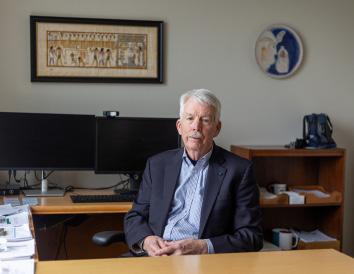
of the summer, Landrigan and his wife would host the students at their home in Westchester County for a barbecue.
“We were just so impressed by the BC students,” Landrigan said. “They were obviously very bright—we’d expected that. What I really hadn’t expected was how deeply the students were committed to social values.”
After seeing these students’ drive for service, Landrigan began thinking seriously about returning to BC.
“Wouldn’t it be interesting to spend a few years at Boston College and have a chance to be around young women and men like those?” Landrigan said. “The thought was in my mind.”
Thomas Chiles, a professor, Deluca chair of biology, and vice provost for research and academic planning, encouraged Landrigan to take these thoughts seriously.
After Landrigan spoke at Global Public Health Day sponsored by the University, Chiles knew he had to find a way to bring Landrigan back to BC.
“His talk blew—as we knew— blew everyone out the door,” Chiles said. “He and I were just talking, and he kind of hinted that he’d like to come home at some point, maybe come back to Boston.”
Landrigan and Chiles went back and forth, mulling over the idea until Landrigan eventually decided to make the move in 2018.
“It wasn’t a hard sell because he was always someone that never left BC, if you will,” Chiles said. “And I think timing was right—he wanted to come back to BC.”
Part of what brought him back were BC’s core values.
“He could have stayed at Mount Sinai, but he wanted to come back here,” Chiles said. “There’s something that drew him back—the same thing that’s kept me here 30-plus years.”
Landrigan was tasked with creating a global public health program at BC.
“If you come here, we’d like you to help us envision what global public health should be, or at least build on what we’ve done, and really make it distinctive,” Chiles recalled telling Landrigan.
As inaugural director of the Global Public Health and the Common Good program, Landrigan set out to do exactly that.
“There’s ways this is distinctive,” Chiles said. “This—the uniqueness of this program—is embedded in ethics.”
Summer Sherburne Hawkins, a professor in the Boston College
School of Social Work (BCSSW) and associate director of the Global Public Health and the Common Good program, worked with Landrigan to bring the program to life.
Before Landrigan stepped in, the deans of the BCSSW, the Lynch School of Education and Human Development, and the Connell School of Nursing had already begun discussing collaborating to offer public health courses.
“We came up with three courses,” Hawkins said. “Once that launched, we ran it for a number of years and realized there’s a lot of interest, a lot of excitement on campus.”
With Landrigan on board, the program began to take off.
“We really wanted to expand it, and then bringing in his leadership, it really was a way to help pave the way to say, ‘We’re having this inaugural director of the program, now we’re going to really formalize it into a minor,’” Hawkins said.
Today, the program offers students the opportunity to pursue either a bachelor of arts or bachelor of science.
Even before the program was officially established, Landrigan was advising students interested in studying public health on their own.
One of these students was Ella Whitman, BC ’23, who was so taken by the field that she decided to create an independent major in it. At the time, the program was only offered as a minor. As a sophomore, Whitman worked directly with Landrigan to develop her own curriculum.
“I worked with Professor Landrigan to get approval as an independent major and go through that process, which was really meaningful for me because I didn’t even know what public health was when I came to BC, but I saw it shine through in so many courses that I took,” Whitman said.
Taking a course with Landrigan solidified Whitman’s interest in public health.
“I took his class in Children’s Health and the Environment, which was probably the most pivotal academic experience I had as an undergrad because it not only expanded my intellectual horizons, but it also showed me the way I want to lead my career,” Whitman said.
The type of career she envisioned was guided by Landrigan’s approach to moral philosophy.
“He carries with him the values that BC imparts on us, to be an ad-
vocate for the vulnerable, to take care of others, to be a man and a woman for others,” Whitman said.
Whitman put her studies to practice when she joined Landrigan’s Global Observatory on Planetary Health as an undergraduate research fellow. The Observatory specializes in children's environmental health, investigating how exposure to both particulate and plastic pollution affects children. The issues Landrigan and the Observatory team tackle are of global significance.
“These are really complex problems,” Chiles said. “And that’s what draws him because they’re so complex and impact so many people. I mean, you’re taking hundreds of millions of people, if not billions of people.”
It is not just the amount of people Landrigan can help that motivates him, but his desire to help those who truly need it.
“It’s in his DNA to care for others that can’t defend their own rights and care for themselves,” Chiles said. “That is his core—as soon as he got his medical degree he jumped into it, and he hasn’t stopped.”
According to Chiles, Landrigan was thinking about these issues long before he obtained his medical license.
“I think he asked that of himself very early on in his life,” Chiles said. “I think he decided, ‘The best way I can do this is to get a medical degree and be a physician.’” For Landrigan, advocating for others has never been solely about research. Instead, his work has always been led by the goal of driving policy change.
“He has spent his life studying and working with lawmakers to change the laws to protect children from environmental toxins,” Chiles said. “Healthcare is a human right, and he’s fighting for the rights of others and for the general population.”
Landrigan has taken his fight all the way to the U.S. Congress— and not just once.
“I’ve always had trouble keeping my mouth shut,” Landrigan said. “On numerous occasions, over many years, I have spoken out in various venues about the need to protect people against pollutants and toxic chemicals.”
Whitman has taken inspiration from Landrigan’s outspokenness.
“I’m so empowered by that aspect,” Whitman said. “Because you can certainly train to be the best clinician or the best research scientist in the world, but it means nothing if you can’t translate your findings to help those most vulnerable and those most impacted.”
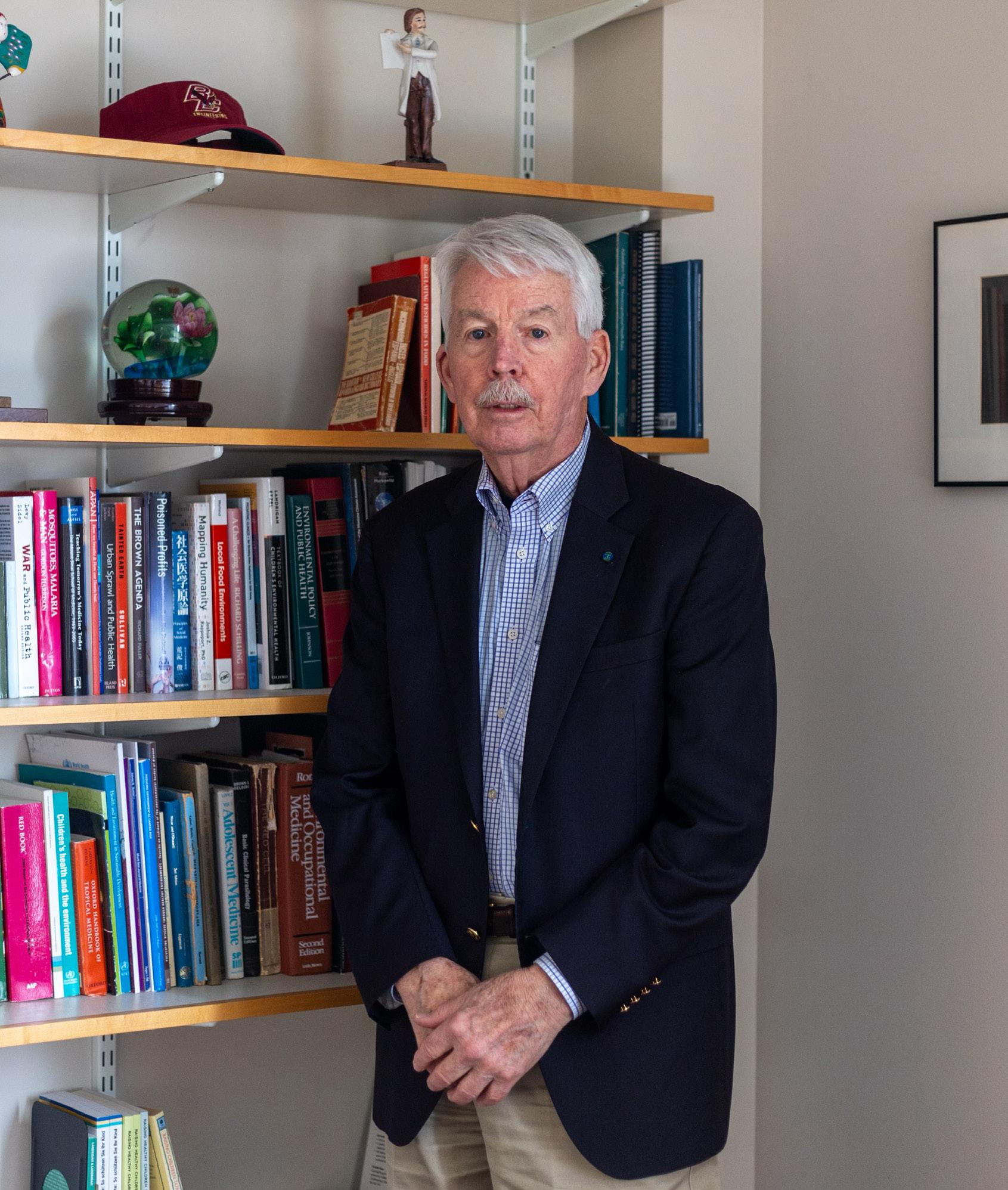
Chiles has also experienced the power of Landrigan’s advocacy.
“Working with Phil, I would say, What have I learned?,” Chiles said. “I’ve learned not to give up the fight because you’re advocating for others that can’t advocate for themselves.”
One moment when Landrigan saw injustice and acted upon it was Congress’ response to Sept. 11 first responders. Landrigan oversaw the medical response to the World Trade Center attacks. He found that many first responders developed abnormalities in lung function because of their service.
Yet, Landrigan found that lawmakers weren’t looking out for the first responders’ health.
“They would pose for pictures with the fire, with the cops and firefighters, with the American flags in the background,” Landrigan said. “And then they would go back to Washington and they would vote against funding for the medical programs to protect those workers.”
Landrigan urged Congress to take meaningful action in support of the first responders.
“That really made me quite angry,” Landrigan said. “I thought it was just wrong, hypocritical. And so I must have testified before the Congress 25 or 30 times about the need to get funding for the brave women and men who had been the first responders after 9/11. And we finally did.”
Landrigan sees similar patterns repeating themselves in the current administration. He believes lawmakers’ rhetoric speaks to upholding children’s health while their actions appear to degrade it.
“The Trump administration has said that their goal is to make American children healthy and get toxins out of American children,” Landrigan said. “And yet, the actions they’ve taken go in exactly the opposite direction.”
According to Landrigan, the Trump administration is rolling back regulations surrounding emissions from coal power plants,
specifically mercury.
“I just find it very hypocritical that an administration that claims to be right-to-life is in fact allowing children—even children in the womb—to be poisoned by pollutants that they’re allowing into the atmosphere,” Landrigan said.
Landrigan pointed out that these rollbacks will only lead to disease.
“If we relax the standards and allow more pollutants to come out into the atmosphere through the stacks of power plants, it’s going to cause disease,” Landrigan said.
Landrigan calculated 20,000 unnecessary deaths as a direct consequence of rollbacks to environmental and occupational rules during Trump’s first term.
“I fully anticipate that we’re going to see at least as many unnecessary deaths this time around, if, unless things change,” Landrigan said.
Landrigan sees three concrete avenues to potentially curb these setbacks: Congress blocks these policies, states band together to
pass strict pollution rules, and people vote in the next election with American health in mind.
“People need to turn out in the next election and vote, not for one party or another, but to protect American health,” Landrigan said.
A group Landrigan views as particularly important to changing the public health political landscape: young people.
“It’s very important that everybody coming of age in America today at least know a little bit about public health,” Landrigan said. Landrigan believes part of the problem is that public health issues aren’t as prevalent as they once were.
“Public health is—in a way— we’re victims of our own success,” Landrigan said. “Over the past 75 years, people in medicine and public health have made enormous strides in conquering disease.”
What happened, according to Landrigan, is that people have gotten healthier.
“Diseases that were commonplace a century ago are now gone,” Landrigan said. “They’re just not part of American life. And most people today, if they’re sick, first of all, they’re much healthier than they were, so people have forgotten how powerful the infectious disease and plagues can be.”
Now, Landrigan urges BC students to take at least one public health course.
“I go out of my way to invite students in every school at BC, every school, without exception, to come and take at least one public health course with us,” Landrigan said.
For many students, Landrigan has not only served as a teacher, but an invaluable mentor.
“He’s extremely generous with his time,” Whitman said. “I see the amount of students who walk through the door with maybe doubts or questions about their career or their life choices, and I have watched so many leave with a new sense of how they want to lead this life.”
Many students might not even understand the privilege of receiving Landrigan’s mentorship, according to Whitman.
“When you speak with him, you probably won’t realize that he’s the reason why we don’t have lead in our gasoline anymore, or lead in our paint, and the trillions of dollars that has saved for our country in the future of children is astronomical,” Whitman said.
Hawkins highlighted how
Landrigan has also become a mentor to the faculty working under him.
“He’s really supportive of students, he’s supportive of faculty, all of us, but—and it’s really that opening opportunities—really getting people to perform to their highest potential, really opening the doors for people,” Hawkins said.
Hawkins believes a major part of Landrigan’s success as a director stems from his commitment to the people he works with.
“Whether it’s introducing somebody just to some other person that they want to meet, writing letters of recommendation, introducing people to others that are thinking about careers— that is what a true director does,” Hawkins said.
Landrigan’s commitment to the BC community is mutual, according to Hawkins.
“When Professor Landrigan either asks you to do something or is leading something it’s very easy to say ‘yes,’ knowing that his ideas are fantastic,” Hawkins said.
Whitman experienced this firsthand when Landrigan offered her a position as an early career researcher at the Observatory.
After six years of working with him, she has come to understand his commitment to his work, as well as to those who will continue it forward.
“Dr. Landrigan makes you feel like you can do anything,” Whitman said. “To be able to give back to the next generation is such a gift, and I know he recognizes that he has it and he’s doing an incredible job sharing that with other kids and students at BC.”
His work is not done yet, and Chiles doesn’t see it slowing down anytime soon.
“He has an inexhaustible supply of energy,” Chiles said. “He doesn’t rest, because the work is never done. I mean, it’s amazing.”
Chiles cannot find an adequate comparison for Landrigan.
“He’s a rare individual,” Chiles said. “I don’t think I’ve ever seen this in my lifetime. I’ve read about it.”
After a long career of reshaping public health across the globe, Landrigan has returned to his roots here at BC.
But in many ways, he never really left.
“There’s no question that all through my professional life, I had tried, to a greater or lesser extent, to live those values,” Landrigan said. n
By KaTherine Malloure Heights Staff
It’s springtime, Eagles! Even though it is still a bit chilly outside, it’s time to ditch the parkas and heavy sweatpants of the winter weather.
But now that it’s too warm for your favorite Aritzia sweatsuit set or classic jeans and sweater combo, what should you wear?
It seems like fashion is finally moving away from the neutral tones and monochromatic color
pallets that have dominated the past few years.
This spring, designers and style influencers are embracing bright colors, bold statement pieces, and fun accessories.
From sequins and embroidery to pastel hues and chic ballet flats, here are the spring fashion trends you won’t want to miss.
Mini Skirts
The ’90s are coming back this spring, with tiny skirts and even tinier shorts making their way

back into the spotlight.
A denim mini skirt paired with a graphic t-shirt, trendy sneakers, and cute accessories is shaping up to be the outfit of the season.
But it’s not just denim mini skirts making waves.
For a colder weather look, try a pleated mini-skirt (think school uniform style) paired with a sweater and trendy sneakers.
Sequin Tops
This spring, it’s time to introduce some textures into your wardrobe.
Sequin tops are popular and make a great statement piece that can be paired with jeans or a skirt to create a perfect outfit.
These sparkly accents aren’t just confined to evening wear anymore—they’re being worn during the day, offering an unexpected twist on everyday outfits.
Pastel Color Palette
Pastels have always been a springtime staple, and this year is no exception.
What’s new this spring, though, is the pairing of pastels with brighter and more colorful

tones.
Combining softer hues with bolder ones allows you to embrace your favorite pastels without being washed out.
Ballet Flats
One of the most anticipated trends of the season is the return of ballet flats.
Ranging from classic black leather to newer styles with embellishments like bows, rhinestones, or metallic finishes, ballet
flats are a perfect complement to almost any outfit this spring.
Florals, an Updated Classic Floral prints always come back into style when the weather warms up, but this season, they’re being refreshed with bold, oversized flower patterns and unexpected color combinations.
The key to wearing florals in 2025 is to choose patterns that blend classic, delicate florals with more modern designs. n
The opinions and commentaries of the op-ed columnists appearing on this page represent the views of the authors of those particular pieces and not necessarily the views of The Heights
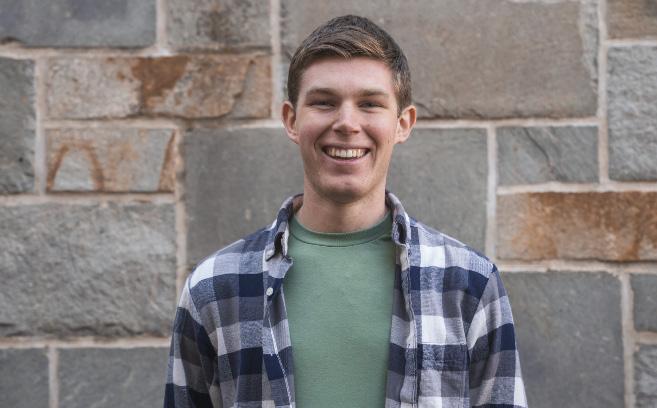
Today, I want to focus on issues that concern us as students, particularly our international peers. The Trump administration is enacting a new executive order concerning these students, and I believe this raises several important questions.
Our first glimpse of this new order came with the arrest of Mahmoud Khalil. This case has been nagging at me for some time now. It’s complicated, and there are valid points on both sides. To better evaluate what our principles should be, we should compare it to another case. The case of Rümeysa Öztürk , the Tufts PhD student, hits close to home and makes for a good comparison.
The key distinction between these two cases, in my eyes, is the nature of their alleged infractions. Khalil was a lead negotiator for Columbia University Apartheid Divest, a pro-Hamas student organization at Columbia University. The government alleges that he not only celebrated the Oct. 7 massacre but also provided material support to Hamas—a designated terrorist organization and self-proclaimed enemy of the United States—by distributing literature that promoted the group and acting as one of its operatives. Several civil lawsuits make similar allegations.
Öztürk’s infraction, however, is less clear. It is apparently an op-ed she co-wrote in The Tufts Daily, in which she urges the University president to engage with the student government on recently passed amendments condemning Israel for its role in the conflict in Gaza and calling on Tufts to divest from companies linked to Israel.
The government’s defenders argue that neither of these students—nor any other foreign students—are American citizens. As such, they say, they are considered guests, and their residence here is a privilege, not a right. That privilege, they contend, comes with conditions—chief among them, not undermining American national security interests.
On the other hand, the student’s defenders argue that freedom of speech must be protected.
Even if Khalil and Öztürk are not American citizens, can we truly claim to have the greatest universities in the world—often recognized as beacons in the search for truth—if all students are not free to express their opinions?
Read the rest of Conor’s argument at www.bcheights.com

Conor Richards is a columnist for The Heights. He can be reached at richarql@bc.edu

isabElla PiErEtti
How do you determine whether someone belongs to a gang of thugs?
Conor brings up interesting questions surrounding the safety of foreign students and government critics, but immigrants from all walks of life are living in fear that they will be designated as criminals and forcibly removed from the United States without due process.
On March 14, President Trump signed a proclamation declaring that his administration would invoke the Alien Enemies Act to detain and remove U.S. immigrants who are from countries considered enemies of the state. More
specifically, Trump claimed that the Venezuelan-based gang Tren de Aragua (TdA),“is a designated Foreign Terrorist Organization” that has “unlawfully infiltrated the United States and are conducting irregular warfare and undertaking hostile actions.” The White House statement also alleges that “[Nicolás] Maduro leads the regime-sponsored enterprise Cártel de los Soles, which coordinates with and relies on TdA” to traffic illegal narcotics in the U.S. and engage in “mass illegal immigration.”
Notably, the Alien Enemies Act, a law from 1798, has only been used three other times—always during wartime. It was used during the War of 1812, World War I, and, most infamously, during World War II to intern Japanese, German, and Italian immigrants. We are not currently involved in a conflict of that scale, which requires Congress to declare a state of war. The president, however, can invoke the law unilaterally in response to an “invasion” or “predatory incursion.”
What do I make of this?
TdA is a transnational criminal organization born in Venezuela’s Tocorón prison, where its leaders ordered extortion, kidnappings, and murders from behind bars before eventually spreading to Colombia, Peru, Chile, and the United States—just a few of the countries now housing the approximately 8 million Venezuelans who have fled Maduro’s oppressive regime.
Anyone in the United States who belongs to TdA—and, more broadly to MS-13 and other established gangs—should be properly identified, detained, questioned, and tried for their crimes and involvement. That’s not up for debate. But invoking the Alien Enemies Act allows government officials to circumvent due process, eliminate hearings in immigration court, and send people essentially wherever they want.
Read the rest of Isabella’s argument at www.bcheights.com



We are watching, in real time, the undoing of a century’s worth of progress. Nowadays, I stew over the continuous affronts on women, executive order after executive order. In a reflection of these changes, the contents of the annual Human Rights Report have slimmed this year, no longer covering the vast sub-categories on rape and domestic violence, reproductive rights, female genital mutilation, and discrimination against women.
The repercussions of dismantling protective policies and freezing funds are felt by multiple communities, not just women. Similarly, less space is being devoted to LGBTQ+ individuals, Indigenous peoples, people with disabilities, and even issues like government corruption in the Human Rights Report. Already, the United States Agency for International Development (USAID) has been shuttered, foiling the global HIV/AIDS effort and hurting humanitarian relief in war-torn countries such as Ukraine.
Of the multitude of hollowed-out agencies, I want to highlight the several that can have the unintended consequence of pulling women out of the workforce and higher education. While it started with the overturning of Roe v. Wade overturn, the devastation to women is ongoing. Most recently, the Trump administration suspended over 35 million dollars in federal funding from Title X, a family-planning program first enacted in 1970 as a bipartisan bill. This program provided expansive, essential reproductive care to millions of lower-income, underinsured
individuals. How is this profoundly damaging to women? One in three women who live in highly restrictive or full-ban abortion states are less and less able to dictate the timing and size of their families. Unfortunately, the same can now be said for women whose primary source of affordable reproductive and sexual health services and access to providers is through Title X-backed health centers, such as Planned Parenthood.
I have grown acutely aware that people have a narrow concept of “reproductive health,” believing that abortions constitute the majority of what it entails. This is an unfounded and inaccurate representation of clinics that provide contraceptive counseling and provision, breast and cervical cancer screenings, STI/STD testing and treatment, basic infertility treatment, pregnancy testing, and preconception services 97 percent of the time. This absolutely encompasses maternal, fetal, and infant health.
When a woman is confronted with an unplanned pregnancy in a punitive state and deprived of funds, her options become finite, leaving her life upended. This is a burden specifically weighing down on women aiming for educational attainment, and it often makes the long-term difference between a poverty-level income wage and a higher-income salary that secures lasting financial stability.
Let’s not forget the providers of services that realize our reproductive rights, who deliver countless life-saving procedures outside of abortions. The medical practices of obstetrician gynecologists, physician associates, nurse practitioners, and midwives are increasingly restricted and criminalized. In some cases, licenses are revoked, and doctors are sentenced for necessary medical interventions performed under ambiguous laws. This provokes the current shortage of OB/GYNs and labor unit closures. And I don’t blame medical students who are cautious of applying to this residency specialty in our post-Dobbs world. Additionally, these fields are popular among women. This is just one example of women of high achievement

Final Stretch April marks the beginning of the end of the academic year. In our last full month, we have tests, papers, discussion posts, and more. In the rush to get everything done, don’t forget to slow down and think about everything this year has brought. It’s hard not to get caught up in the Marathon Monday and Mudstock madness, or in frustration with mounting due dates. But wow, we’ve all come so far! Next time you find yourself frustrated with just how busy this last month is, just know you’ll be missing this all once we’re out.

Showdown Showdown was this Friday, and wow, were we impressed. BC has one the most extensive dance cultures in college history, so Showdown never disappoints. BC Dance Ensemble took home first place with an incredibly entertaining performance centered around women in show business Masti won the Crowd Choice award after telling the story of a lower-caste South Indian Boxer, and BC Irish Dance and Fuego were also recognized. From Sexual Chocolate to Synergy, the performances this year exceeded all our expectations.


Rain, Rain Go Away
being forced to resign.
While abortion laws are state-specific, family planning and counseling services funds are being sheared across the country. Title X physicians, clinics, and services will remain implemented as long as federal grants from the Department of Health and Human Services are disbursed. The potential withholding of Title X funds will lead to proportional reductions in cancer screenings, increased rate of STI/STD transmissions, and worsening maternal health outcomes. The cascade of harm set in motion by tightening budgets threatens women’s lives and encroaches upon providers’ duty of care.
You may not support elective or even medically necessary abortions, yet at some point, you will personally know a woman that sustains these ideologically-driven executive order barrages. It could be her struggling to access some form of contraceptive, receive IVF treatment, or access other basic reproductive support. Those people who provide abortion care are the same people providing other reproductive healthcare.
It could very well be a peer at BC who relies on her birth control prescription from Planned Parenthood to keep her PCOS symptoms at bay. It could be that a classmate needed mifepristone, obtained from a Title X healthcare organization, to stay in school. There are medical services not covered by BC health insurance, so chances are female BC students look to Planned Parenthood affiliates for confidential and covered contraceptive methods or procedures.
Let it not be lost on us how closely tied health outcomes and reproductive care policies are to women’s futures. As college students in Boston, we are lucky that our rights are protected under the Massachusetts State Constitution. It is only when every woman is entitled to make timely and fully informed decisions that we will truly embrace women as creators of life inside and outside of the womb.
We just looked at the forecast for next week, and yup, you guessed it: rain. In fact, maybe even a little snow? I know spring weather isn’t always ideal, but it feels like forever since we saw the sun. Where are those random 80-degree days that March and April usually bring?
Unfortunately, you can’t have flowers without a little rain. So, next time you get caught in pouring rain walking back from class, maybe it’ll make you feel better to think about how campus beautiful campus will look in the warm weather which happens after we leave for the summer, of course.

Tours Are Everywhere Congrats to the admitted Class of 2029! Unfortunately for the current BC students, this means tour groups have once again begun crowding up our campus. It’s frustrating to leave Mac and have to weave around giant groups of immobile high school seniors. Nevermind that they’re gawking at you like zoo animals. Though some people like extra eyes while on their way to class, we find it to be very inconvenient. To avoid being bothered, I’ve tried putting myself in their shoes—remember when it was you taking those tours? That, and taking the long way to class.
After an overwhelmingly negative experience in her Spanish classes at Boston College, Sophia Fee, MCAS ’27, decided to finish her language requirement in a summer class at the University of Rhode Island.
The rigid structure of the courses, driven by teachers who have to focus more on rules than engagement with their students, drove Fee away from BC’s Spanish program.
Her experience is not unique.
BC’s Spanish program is micromanaged, creating tense classroom environments and, ultimately, worse student experiences. The program needs to let its teachers teach—if they don’t, there’s no way for its students to thrive.
Over 850 students enroll in Spanish classes through the department of romance languages and literatures (RLL) every semester. In serving such a large block of students, the program focuses on making course curriculum and grading standards uniform across all sections. But in doing so, it stops professors from tailoring courses to suit their pedagogical strengths.
The RLL chair and program coordinators decide the curriculum based on the American Council on the Teaching of Foreign Languages’ national standards. The department determines the grading policies and rubrics, but the coordinators determine
the standard syllabi for each level of the class and enforce the policies.
We agree that students should expect the same quality of instruction, regardless of their professor. Problems arise, however, when the strict enforcement of these rules demotivates teachers and leads to low student morale. The Spanish program must work to strike a balance between ensuring uniformity and building a healthy learning environment.
A former Spanish professor said teachers felt excessively supervised, which led them to manage and grade students more harshly than they would have otherwise.
“We had no freedom, couldn’t possibly question, and couldn’t teach or grade anything without having to explain ourselves,” the former professor said.
Students are often the victims of the stress put on their professors.
The former professor found that in order to award a high participation grade to a student, they would have to be prepared to justify their decision to the department.
Even hearing a student speak English once during a multi-week participation period would affect their grade.
This is just one example of an unrealistic expectation that frustrates teachers and students alike.
“Teachers have to check every single thing on the rubric to find ways of not giving students a really high grade,” the former professor said.
This rigidity of classroom instruction is perhaps unsurprising if you consider the rigidity within the Spanish program itself.
The former professor said suggestions as simple as subtly rephrasing an exam question were extensively challenged at course team meetings.
“With time, some professors just decided to stop suggesting things because we knew that it was not going to change or it was going to become something bigger,” the former professor said.
This is not all to say the Spanish program is plainly authoritarian—they encourage student feedback.
“If they don’t come to me, then I can’t do anything about it,” said Franco Mormando, RLL department chair. “I’m always very eager to have feedback from students.”
While listening to students is essential, the Spanish program should reframe its philosophy to welcome and engage with constructive criticism from teachers as well.
Unfortunately, the Spanish program has yet to welcome this discourse.
It is crucial that program administrators empower professors and trust their abilities,
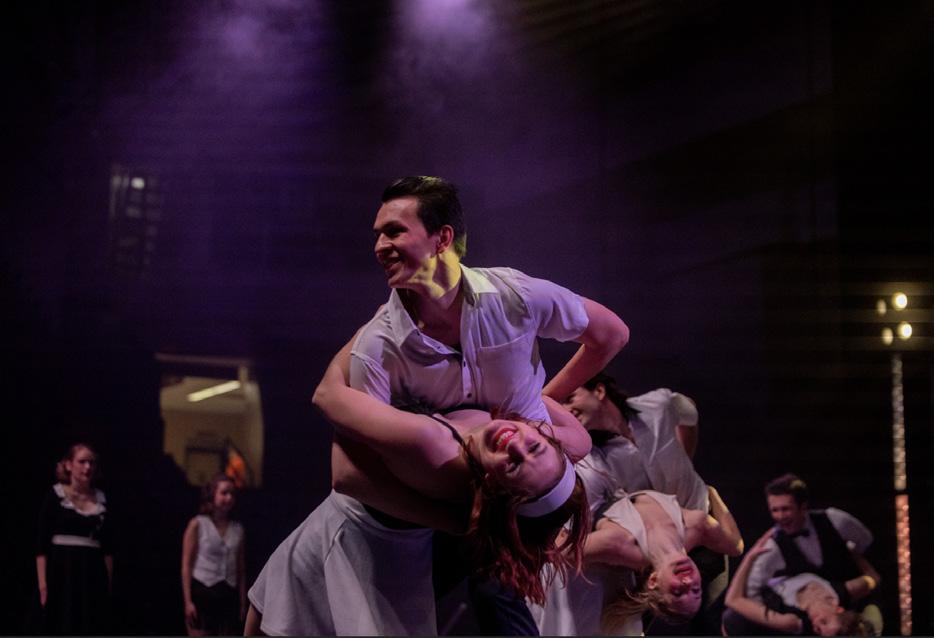
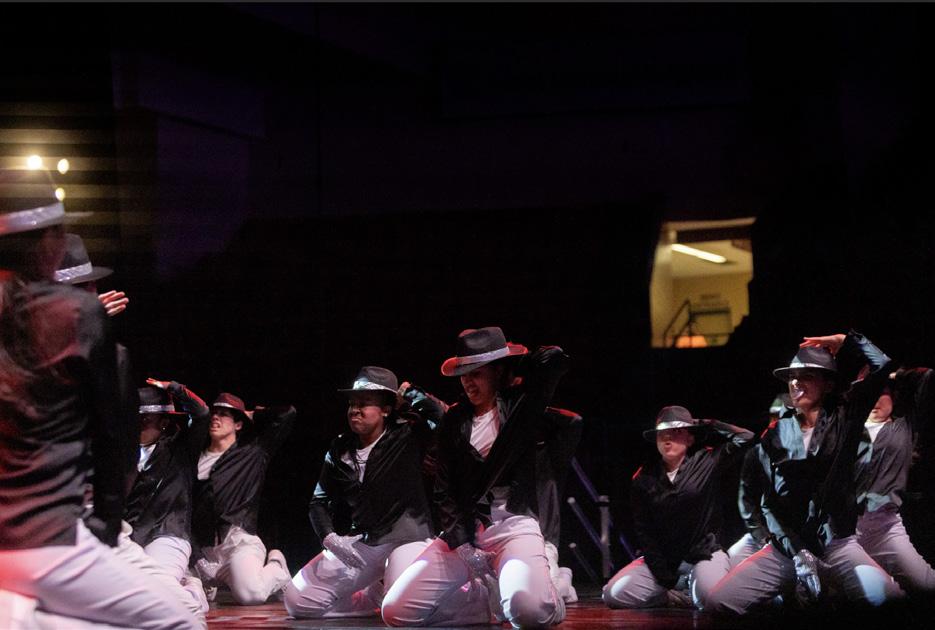



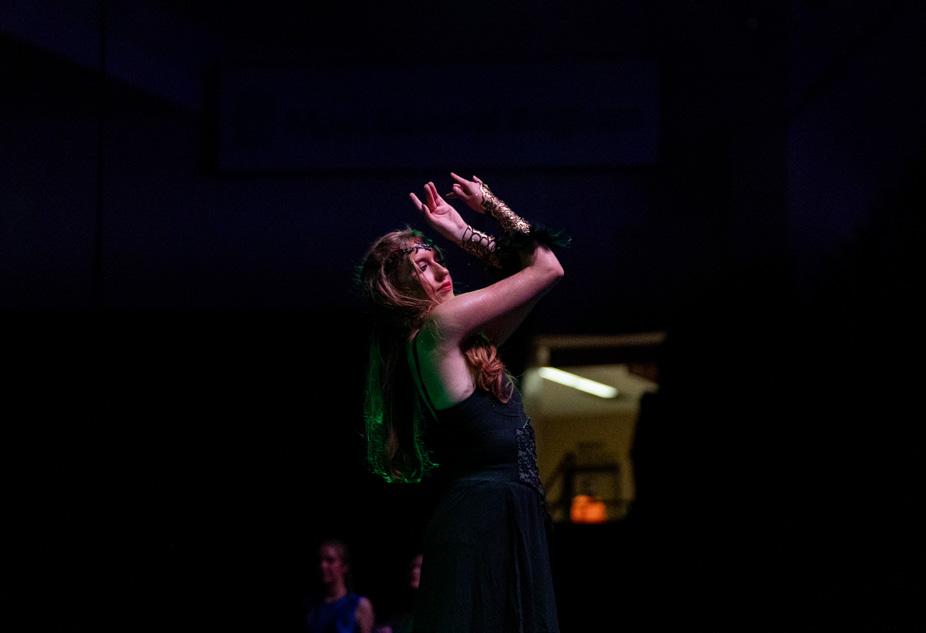

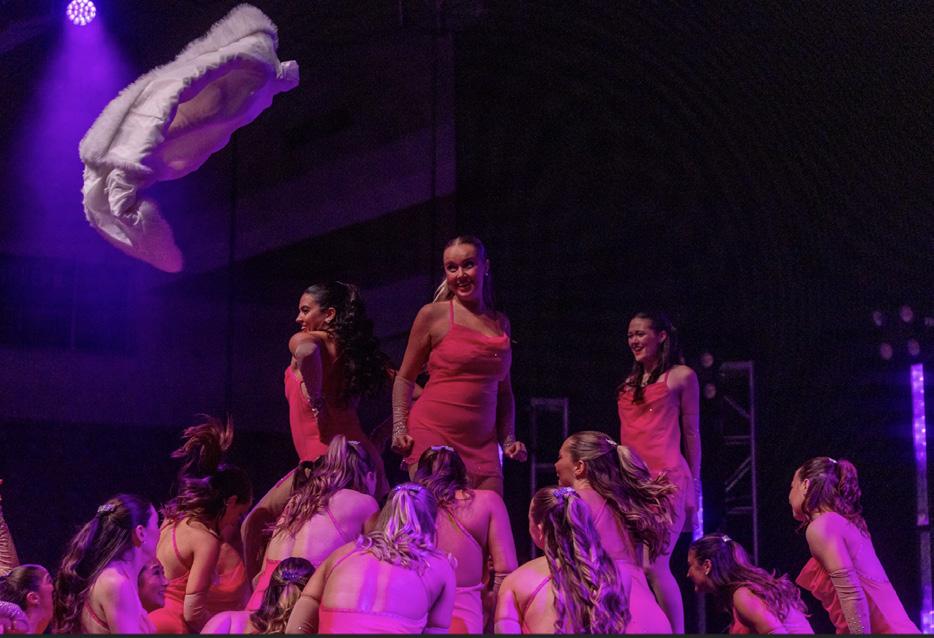
B y M addie M ulligan
Arts Editor
Maria Beatriz Saldanha
Assoc. Arts Editor
Milo Priddle
Asst. Arts Editor
Boston College’s ALC Showdown 2025 celebrated dance in a big way this year. With a line of people snaking around Conte Forum by the time doors opened at 6 p.m., students anticipated a riveting showcase of BC’s dancing talent—and they did not leave disappointed.
This year’s hosts, Saron Yared, ALC director and MCAS ’25, and Na’Sah Dabbs, ALC assistant director and MCAS ’25, warmed up the audience with jokes, cheering exercises, and a bit of the event’s history.
Showdown is a yearly competition among BC’s 17 dance groups, with the prize money going to the winner’s charity of choice. The firstplace winner, BC Dance Ensemble, donated its winnings to the Campus School at BC.
Second place was awarded to BC Irish Dance, and third place went to Fuego del Corazón. Masti was named Crowd Choice winner after earning the loudest round of applause from the audience. BCbased singer-songwriter CARAMEL performed one of his original songs while the judges deliberated, keeping the audience entertained.
Each team focused its performance around a cultural theme to promote the ALC’s efforts toward diversity and inclusion of minority groups on campus. Before each performance, a video featuring leaders of the team explaining their concept and rationale aired on the screen above the stage.
(AeroK)
AeroK opened the show on a strong note—its hip-hop, urban style of dance brought the crowd to immediate cheers. The group’s theme this year was “Our Storybook,” dedicating its performance to a reflection on history and culture.
Using a storybook prop to begin and end the performance, AeroK combined fluid and traditional hip-hop movements to mesmerize the audience. Clad in black and red outfits—the women in red tops and black pants, and the men in all black with red bandanas—the group wove a variety of dynamic scenes into their set.
The crowd only grew louder as recognizable songs like “SLOW DANCING IN THE DARK” by Joji played, the cheering breaking up the continuous dancing.
Fuego del Corazón
Fuego del Corazón hit the stage with their signature high-energy flair, delivering a performance rooted in Latin rhythms and rich cultural tradition. This year’s theme, “Lost Legends: A Dance Through Latin American Folktales,” felt like a tribute and celebration all at once.
“Through movement, we bring to life the myths and legends passed down for generations—stories of love, resilience, and mystery that continue to shape our culture today,” the video preceding its performance said.
The setlist was just as vibrant as the choreography, blending everything from fast-paced Colombian salsa to bass-heavy Brazilian funk. But what really had the crowd screaming? The jaw-dropping partner lifts—dancers spun mid-air in wide, sweeping arcs.
The men wore all-black outfits with subtle red details, creating a sleek backdrop for the female dancers, who took center stage in glittering red halter-neck dresses with ruffled skirts.
The group’s third-place prize was donated to La Colaborativa, a Boston-based organization that supports Latinx immigrants by providing resources for economic mobility, social services, and advocacy.
UPrising
UPrising, founded as a hip-hop and stunt team, followed. Dressed in red and black, the group’s performance was impressively eerie, exploring puppetry power dynamics.
The distorted, dystopian audio provided the interlude between dances and framed the developing narrative. At times, the dancers would physically direct each other’s limbs, acting as both puppet and puppeteer. The movement was consistently jolting and unpredictable.
The group also included iconic songs such as Kanye West’s “POWER,” which further won over the audience.
BC Irish Dance (BCID)
Following a performance by members of ALC to “Not Like Us,” BCID took the stage, putting on a performance that improved on last year’s third-place finish to secure second place. To celebrate history and cultural richness, BCID formed its routine around a tale from the Táin Bó Cúailnge, an Irish folklore epic.
Most members wore glittery blue dresses with brown corsets, while the shapeshifting goddess of war, Morrigan, and demigod Cu Chulainn stood out in all black and all green, respectively. Telling the
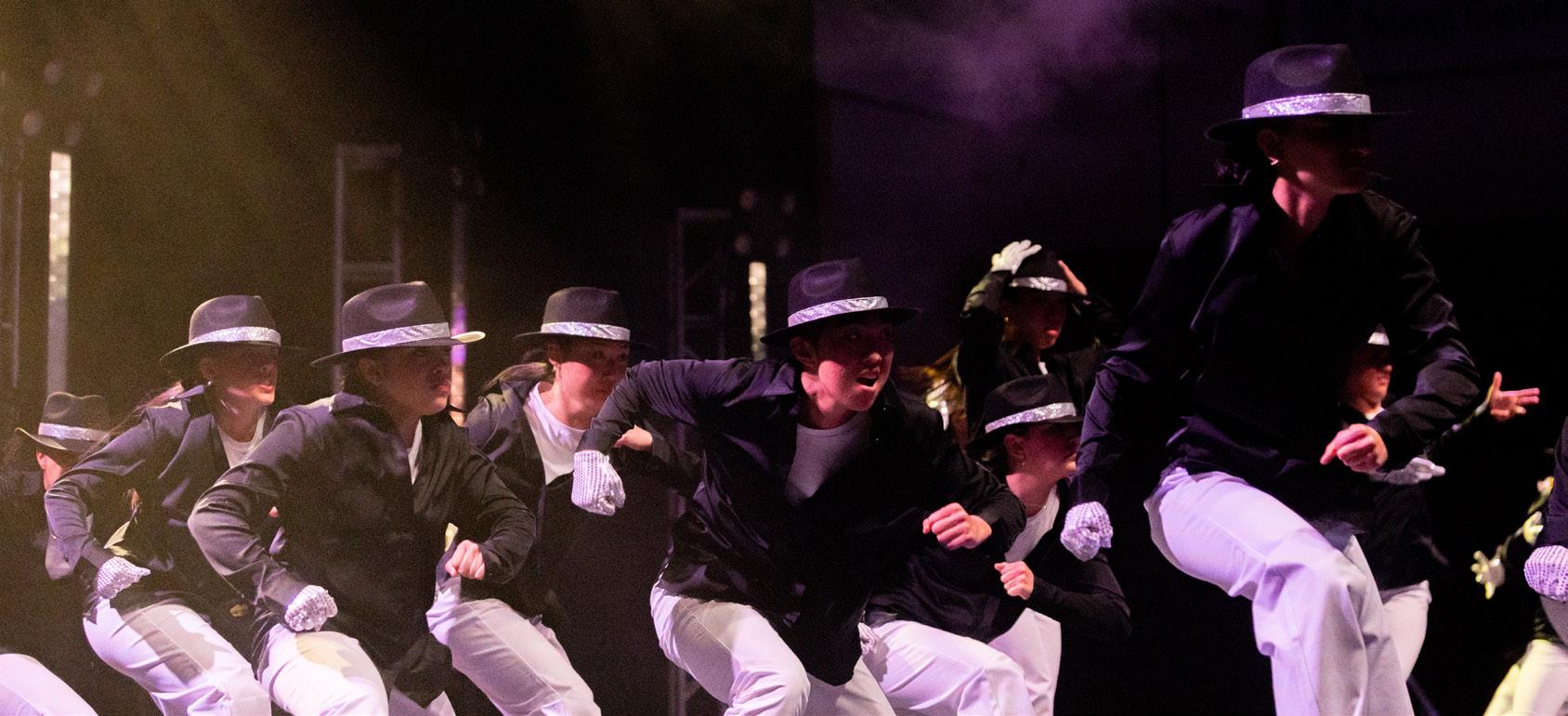
story through dance with impressive poise, it was immediately clear that BCID wasn’t playing around this year.
The dancers had quick costume changes offstage to keep the story going, flourishing to “Take Me to Church” by Hozier—another ode to Ireland.
The music cut at the end, so only the steps of the dancers could be heard, uniting with perfect synchronization. Breaking into fast-paced, spinning circles before lining up into a traditional Irish dance formation, BCID celebrated convention while also pushing the limits.
Golden Eagles Dance Team
With a focus on the vilification of women throughout history— especially those who defy societal expectations—the Golden Eagles Dance Team’s theme this year was “Witch Trials.”
A haunting mood was immediately set with Lana Del Rey’s “Once Upon a Dream” as the all-girls group took the stage in red leotards and flowing black capes.
What started as a lyrical, spellbinding performance quickly transitioned into the team’s iconic high-intensity pom and kickline choreography, set to more upbeat tracks like Taylor Swift’s “I Did Something Bad.” Every song choice echoed the theme, with lyrics invoking fire, burning, or revenge. Shimmering amber flags amplified the fire motif, adding visual drama and making the performance even more impactful.
Synergy Coming off a second-place finish at last year’s Showdown, the expectations were high for Synergy Hip Hop Dance Company—and,
per usual, they delivered. The group’s theme honored two hip-hop legends: Michael and Janet Jackson.
Their tight black and white outfits, accompanied by the iconic hat and gloves, were wholly Jackson-esque. The group’s dance was fluid and smooth, just like the music they danced to—including “Smooth Criminal.”
Their musical setlist was impeccable, featuring “P.Y.T. (Pretty Young Thing),” “Scream,” and “Don’t Stop ’Til You Get Enough,” among other classics. With such recognizable music, the crowd was animated throughout the performance.
Full Swing
Full Swing took the crowd on a trip through the decades, aiming to showcase how swing has developed over time.
The dancers walked on stage to The Twilight Zone ’s theme music, carrying other dancers completely sideways in their arms. The music quickly kicked in as “Dance With Me Tonight” by Olly Murs spurred the first dance.
Members wore clothes from different decades, taking center stage while their pre-performance video explained their theme. Roaring ’20s–style swing featured bow-tied dancers while more formal clothing was worn for “Rockin’ Robin.” Embroidered shirts and tassel vests were worn for country swing before casual, but modern clothes were worn for “Put Your Records On.”
Full Swing ended its performance with a return to “Dance With Me Tonight,” merging their own style with iconic swing styles of the past.
Read the rest of this story at www.bcheights.com

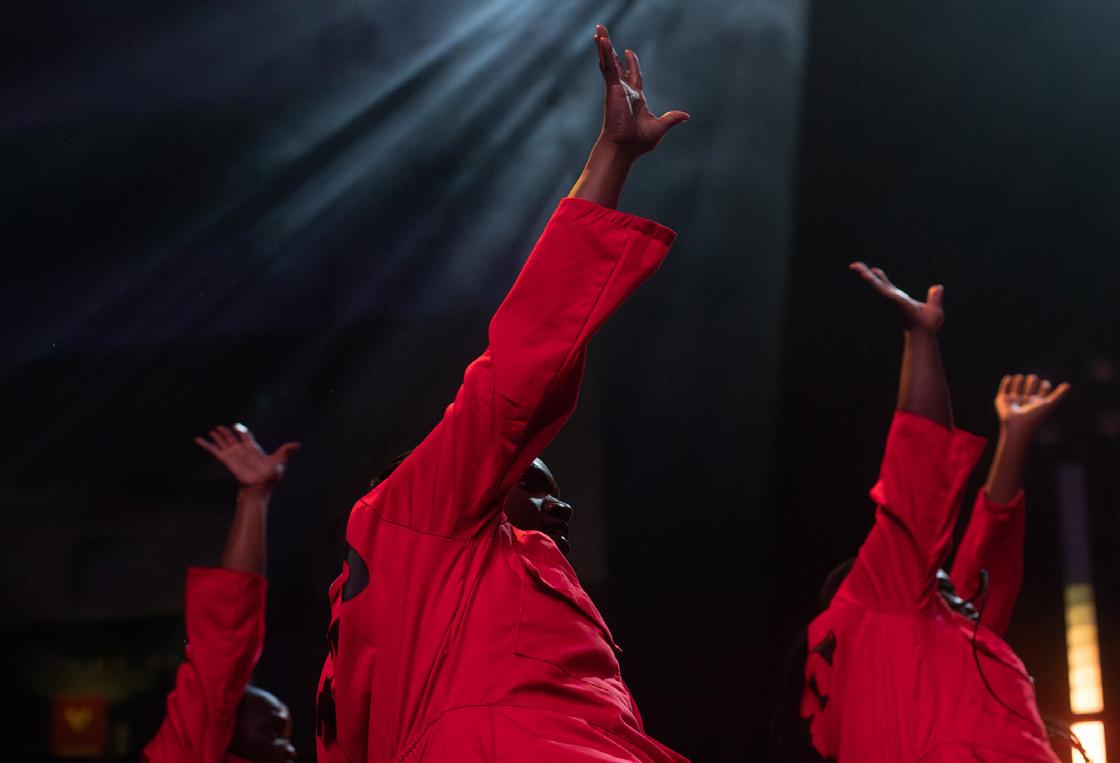
Asinine Delivers ‘Hey Siri, don’t be afraid’
By ClanCey Benfer Heights Staff
Students filed into Fulton 511 on Thursday evening for yet another night of comedy on campus with Asinine Sketch and Improv Comedy’s big show, “Hey Siri, don’t be afraid.”
Asinine, Boston College’s only improv and sketch comedy group, opened the show with a montage of a member leaving the group only to be haunted by his memories with the Asinine mascot. The video followed the Asinine member all around campus with Barbra Streisand’s “Memory” playing in the background until he eventually reunited with the donkey. And with that, the acts began.
The show alternated between sketch and improv acts, an upbeat song playing between each to keep the audience engaged. The first sketch was Stu’s Moment, which follows hipster Stu, who’s just a little too into the bongos and slam poetry. Stu’s absurd dance moves and multiple coffees spilled on other Asinine members started the show off strong. After, the group performed their
first improv game called the Death Game. The audience gave the actors a location and various ways of dying. The improvers then created a scene based on these suggestions. It ended with all four members dying in humorous ways.
The next sketch took a bit to get to the punch, but had the audience rolling in the end. A seemingly unengaged college student gave a passionate and incredibly serious presentation about using CRISPR gene editing to make a burger man who is “equal parts man and meat.”
This was followed by the improv game Good, Bad, Ugly. Audience members proposed questions they needed advice on, and Asinine members offered good, bad, and ugly advice for their problems.
The following was a sketch of a man trying to propose to his girlfriend, but the other restaurant attendees do not make it easy. The pure randomness of this one had audience members in stitches. The addition of the improv game Party Quirks simply added to the hilarity.
The host left while audience members
decided on the quirks of the three remaining members on stage. The host then guessed each party-goer’s quirk through their act.
Another entertaining, though raunchy, sketch was Mancala. Skilled mancala player Chlamydia Onyourjohnson beat two other humorously named opponents before being bested by Jack Loosefingers. The sketch was peculiar, with random jabs at “anemic PhD students” that got the audience laughing.
Next was the widely performed improv game, Growing Shrinking Machine. Five different scenes from one inspiration—“spy” in this case— took place with Asinine members rotating in and out to grow and then shrink the group.
A sketch called Hell Week came after, which portrayed the initiation for the new Sigma Nu of BC. One of the characters was a little too enthusiastic about rushing, fully embracing any punishments the brother in charge came up with. The sketch ended with a cackling audience, the stage clouded in baby powder after the overly enthusiastic brother was
hit with a sock full of it.
Two Asinine members subsequently took the stage to play Lines in a Pocket. The two members improvised a scene of two men in prison, having to incorporate phrases the audience members had written before the show.
The penultimate sketch was short and sweet: Jesus Christ, Rookie Card.
Two members with incredibly strong New York accents find a baseball card for Jesus. Unfortunately, the card ends up being destroyed. Thunder sounded—God’s wrath—and the lights went off before the last improv game of the night.
Four Asinine members participated in Irish Drinking Game, where they had to make up a song to a
stereotypical Irish tune. They cleverly created a melody about going to the beach, achieving an impressive number of rhymes for a song made on the spot.
The last sketch of the show was Graduation Day in Space. With a galactic BC logo on the screens behind them and an EDM version of classic graduation music, various students received their diplomas via Bluetooth. One character, Roland Plarb, was particularly ambitious. He graduated with a 4.0 and received progressively more controversial degrees, the last of which was Advanced Racism. With raunchy sketches and impressive improvisation, Asinine let its unique skill set shine with “Hey Siri, don’t be afraid.” n

By Nikita Osadchiy Asst. News Editor
Most would approach A Minecraft Movie with the wide-eyed hope of stepping into a blocky wonderland—a bigscreen reimagination of the pixelated sandbox game that defined an entire generation. Naturally, one would assume the adaptation is a cinematic portal into a world we’ve mined, crafted, and dreamt of for over a decade.
But alas, the film falls short of our nostalgic wishes.
Rather than immersing the viewer in the familiar thrill of exploring the Overworld’s endless biomes or battling the Ender Dragon with enchanted gear, A Minecraft Movie seems oddly eager to flee its own universe. The characters spend more time trying to escape the very realm we once longed to enter than actually basking in it.
The film opens with several minutes of narration from Jack Black, voicing Steve—the face of “Minecraft.” Through Black’s exposition, we learn that Steve—the fearless explorer of my childhood imagination—was just a bored office worker. Apparently, he led a thoroughly mundane 9-to-5 life until he discovered a mysterious artifact in
a mineshaft, opening a portal to the “Minecraft” Overworld.
The artifact finds its way back to Earth, to a small town in Idaho, where we are introduced to our ragtag crew of protagonists: orphaned siblings Henry (Sebastian Hansen) and Natalie (Emma Myers); Dawn (Danielle Brooks), a real-estate agent whose car doubles as a petting zoo; and Garrett (Jason Momoa), a debt-ridden, washed-up arcade champ clinging to his glory days.
Eventually, in what can only be described as a ripoff of Jumanji, a sequence begins in which Henry stumbles upon an artifact at the arcade and ends up getting sucked through a portal into the world of “Minecraft” with the rest of the group.
This sequence takes place a full 25 minutes into a 100-minute film, meaning we spend a quarter of the runtime nowhere near the setting people came to see. But now that they’re finally there, the plot seems determined to shuttle them all back to the small Idaho town where they are unequivocally losers.
Soon after their arrival, the artifact is destroyed during a chaotic brawl with zombies and skeletons, who look
like David Cronenberg nightmares rendered in cubes. With no way home, the group teams up with Steve to travel to a Woodland Mansion in search of another artifact. Because, of course, a spare of such a rare item exists.
The film flirts with the signature “Minecraft” mechanics—building, mining, crafting—but never commits.
At one point, Henry constructs a tater tot launcher, an item that does not exist in the real game, at a crafting table. It might have been charming if it weren’t so obviously out of place.
Meanwhile, Steve somehow possesses items that, canonically, he should absolutely not have based on his apparent in-game progression.
Command “/c” and “/give” do wonders, I guess.
By the midpoint, the movie’s flaws become even more glaring.
The acting ranges from painfully stiff to oddly overwrought. Black is annoyingly over-expressive as if he were pulled straight out of a live-action Tom and Jerry. Hansen and Myers deliver performances so flat they could fit them in their own hotbar. And Momoa and Brooks aren’t much better.
It’s hard to say whether the fault lies more with the writing or the
weary expressions on their faces that scream, “How did my agent convince me of this?”
With a reported nine-figure budget, it feels like only six of those digits actually made it to the screen.
Paper-thin plot and clunky performances aside, there is a glimmer of what the movie should have been.
As someone who grew up with “Minecraft”—and still plays from time to time—it was genuinely special to see pieces of my childhood brought to life. Watching Henry build a castle and stand proudly inside it, visiting a “Minecraft” village, and dodging Ghast fireballs all in real life—my childhood self would have exploded with joy.
The moment a chain reaction of Creepers combined into one massive explosion—a feature not even possible
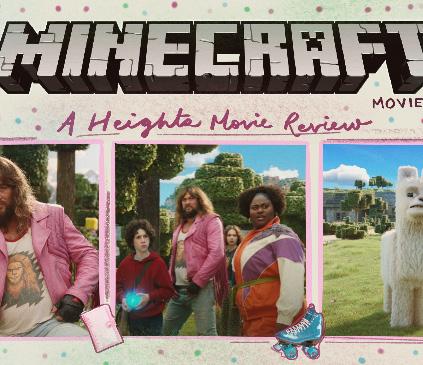
in the game—sparked that nostalgic, sandbox-fueled thrill of “what if.” And yes, when a wolf appeared, tamed and every bit as adorable as I imagined, my heart melted a little.
Without those moments, the film would’ve been a total nightmare. But it manages to scrape by on nostalgia alone—in the small amounts of it that there were.
Still, it’s a bit insulting that the story expected us to care more about the awkward misfit teens and their earthbound drama than the very game we came to see.
The title A Minecraft Movie implies it’s just one of potentially many. Maybe one of those installments will offer better acting, better storytelling, and—dare I dream—better jokes. Or perhaps they will be worse. But honestly, I’m not sure that’s possible. n
A Minecraft Movie Released April 4
By a Ngeliki ktOridi Heights Staff
Recently, I’ve gone down a rabbit hole of watching video essays on YouTube. Usually focused on contemporary literature or hot takes on certain celebrities, I must admit that I watch them religiously. So, I thought nothing of it when I sat down for my typical routine and came across a video of Gabriel García Márquez’s son talking about his father, the renowned Latin American writer.
After some quick searching, I realized the channel I had stumbled upon was none other than Dua Lipa’s. A new obsession had bloomed! Naturally, I began watching all her videos. Her channel, Service95, is an editorial platform founded by the singer
herself—with its own website and newsletter—that posts articles and podcasts on all things culture, travel, fashion, and, my personal favorite, books. I must admit, however, I was pretty hesitant about it at first.
Having consumed so many video essays and countless SubStack articles discussing the recent wave of celebrity “hobbies,” I wasn’t sure whether Service95 was just another superficial publicity stunt.
As of late, there has been a surge of celebrities launching their own book clubs—from Reese Witherspoon to, surprisingly, even the Kardashians. But is it authentic or just another grab for publicity? As cynical as it sounds, can you really blame me for being skeptical every time a celebrity suddenly develops a literary interest?

Considering some are even hiring book stylists, I think it’s fair to say I won’t let just any book club or podcast slide.
With that, it’s rare to find celebrities who pursue hobbies based purely on personal interest rather than financial or public gain, so I was understandably skeptical when I saw Dua Lipa’s channel filled with interviews featuring some of my favorite writers.
Service95, however, truly exemplifies how modern media platforms can merge influence with substance. Its commitment to authenticity, cultural literacy, and global perspective makes it more than just a digital brand—it genuinely stems from Dua Lipa’s curiosity and love for literature and culture.
“Consider us your cultural concierge: serving up insider recommendations and global stories featuring some of the world’s most compelling voices,” reads the website.
In the YouTube series Dua Lipa In Conversation, Dua Lipa seamlessly interviews a range of incredible creators. The featured authors span from niche writers to big names—I love how inclusive it is, and her interviewing skills are phenomenal.
It doesn’t feel like a staged interview, where the questions are awkward or the chemistry feels forced. Instead,
she transforms the exchange into a natural conversation, with questions that flow organically and keep the viewer engaged for so long that you don’t even realize 45 minutes have flown by. I have to admit, it’s happened to me more than once since coming across the channel.
Another reason I genuinely adore Dua Lipa and this precious hobby she’s curated is that now more than ever, it’s so important to engage with the world around us—especially since the purview we’re living in is so culturally diverse.
Our contemporary society has failed to even read for classes, let alone for leisure.
But when your favorite international pop star invites an array of authors to have a small chat, purely out of her own interest, it can truly impact the way younger generations think about reading. At the very least, it engages people with authors, whether they’ve read the book or not.
At most, it gives the literary-oriented something to watch or a new book to read. It’s a great space for every book lover to indulge in all things literature.
But it doesn’t stop with literary lovers— Service95 is for everyone.
The platform has its niches, but it also curates its content to the general public. Dua Lipa actually engages with
her audience.
Parts of the newsletter, website, and YouTube channel include articles, videos, and podcasts ranging from style and fashion to activism, often highlighting marginalized voices and humanitarian crises. It truly has something for everyone.
“This is a space where you can delve into the world of creatives while also picking up well-being tips,” the website reads. “Where you can find out more about the lives of people across the globe and get advice on how to advocate for social change.”
Of course, the book club component is my personal favorite. The monthly book club newsletter invites you to see what Dua Lipa is reading, but the interview segment will always take the cake.
“Where you can read deep-dives on identity or dating and discover the books you never knew you needed to read,” the website reads. “This is the world, curated for you.”
Basically, Dua Lipa is one of the best interviewers I’ve come across. Beyond genuinely enjoying her music, I love seeing celebrities be human and engage with expansive and inclusive content across different sectors. It’s refreshing to know that not all celebrities are confined to the secluded bubble many assume they live in. n
By Maddie MulligaN Arts Editor
As Marathon Monday quickly approaches, students are scrambling to prepare for one of the biggest days on Boston College’s campus. From buying outlandish outfits to planning when to make the trek off-campus and back, MarMon is a day that finds students doing the most to celebrate one of Boston’s greatest traditions.
This celebration comes to a head with the Mile 21 Concert, which is held in the Mod Lot at 10 a.m. With the announcement of Saweetie as this year’s headliner, many students flocked to their music-listening app of choice to familiarize themselves with the artist.
Though known for her songs
“Best Friend (feat. Doja Cat)” and “My Type,” Saweetie’s lack of mainstream popularity leaves the extent of her concert setlist likely unknown to many. But The Heights is here to help with a playlist of our own to better your Mile 21 Concert experience. Starting out with Saweetie’s top
hits, it’s songs like the two above that launched Saweetie into the spotlight in 2019 and are sure to be crowd favorites at the concert. The pinnacle of her career came in 2021 with “Best Friend (feat. Doja Cat).”
But Saweetie had spent years before growing her music persona.
Starting out by posting clips of freestyles to her Instagram, Saweetie’s big break came with the song “ICY GRL,” her 2017 debut single initially released on SoundCloud. Once gaining traction, the song landed Saweetie a record deal with Warner Records and a double platinum certification by the Recording Industry Association of America.
“Manicures and pedicures, I’m always tip top / When they say I’m not hot, all these lies need to stop / ‘Cause I’m icy, wifey, haters wanna fight me,” raps Saweetie at the beginning of “ICY GRL.”
Saweetie then created her own record label, Icy Records, in 2018 and released her major label debut EP, High Maintenance, shortly after. The EP features hits like “ICY GRL”
and the 49-second title track “High Maintenance.”
The playlist also includes songs from Saweetie’s next EP, ICY , released in 2019. With “My Type” on it—Saweetie’s first song to enter the Billboard Hot 100 list—ICY also has one of her many notable collaborations with “Tip Toes (feat. Quavo).”
Saweetie began collaborating with other popular artists in 2020, and many of her top songs are now the result of those partnerships. From her “Tap In” remix with Post Malone, DaBaby, and Jack Harlow to a feature on Ava Max’s “Kings & Queens Pt. 2 (feat. Lauv and Saweetie),” Saweetie has built her career with the help of some of the biggest names in pop music today—potential for a surprise performance of the Mile 21 concert.
Many of Saweetie’s recent setlists have included collaborative songs, like “Back to the Streets (feat. Jhené Aiko)” and “Closer (feat. H.E.R.).”
With a repertoire of impressive partnerships built up over the years, Saweetie has a fair amount of sleeper
hits to pull out at Mile 21.
“I ride around town ‘til I leave / I gave the boy around, spit him back to the streets / Like, la-da-deeda-dee-da,” sings Saweetie in the chorus of “Back to the Streets (feat. Jhené Aiko).”
Saweetie’s personal hits and striking collaborations are what helped to land her on the Forbes 30 under 30 Music List in 2020, the year of her first beauty collaboration and the launch of her own virtual educational content series, Icy University. Since releasing her hits, Saweetie has performed throughout the Unit-
ed States and continued to write new music. Performing her then-newly released song “Icy Chain” on Saturday Night Live in 2021 and releasing her EP THE SINGLE LIFE in 2022, Saweetie has been a consistent artist since her first Instagram post. Saweetie might not be mainstream anymore, but her hit songs and collaborations are sure to be thoroughly entertaining for the Mile 21 crowd. And who knows, maybe BC students will be rewarded with a well-deserved surprise performance from Doja Cat after a long school year. n

B y M aria B eatriz Salda N ha Assoc. Arts Editor
The Boston Marathon has always been a test of endurance, but runners will argue it is also a form of expression. In recent years, more and more athletes have started to share their journeys online. On social media, the race isn’t just about pace and placement anymore—it’s about documenting the process: the struggle, the strategy, and the story.
For runners like Brett Chody, a former University of Southern California track athlete turned influencer, the marathon becomes more than a finish-line fixation—it’s a way to show what pushing your limits looks and feels like. And with the right fuel (or bites), gear, and music, even our infamous Heartbreak Hill starts to feel within reach.
If the name doesn’t sound familiar, her voice might. A clip from Therapuss —a podcast hosted by her roommate-slash-best-friend and content creator Jake Shane—went viral on TikTok, featuring Chody as a guest.
“Not to sound, like, really stupid, but is the Boston Marathon longer than the LA Marathon?” asked Shane.
“No, all marathons are the same length,” Chody said. “That’s common sense, I fear.”
While many sports influencers focus solely on physical performance, Chody blends running with food, lifestyle, beauty, and pop culture. In doing so, the 24-year-old Illinois native has found her niche, her ever-growing fanbase its living proof. Best known for her online
profiles named “Brett’s Bites,” Chody has amassed more than 80,000 followers on Instagram by sharing her life in motion (and in meals).
Chody started running in the seventh grade, ran varsity cross country and track all four years of high school, and went on to compete at the Division I level at USC. But just months into her freshman year, a series of injuries forced her to temporarily step away from the sport.
“At that point, I was incredibly burnt out by the sport,” Chody said.
After graduating college, though, she found her way back to running—this time on her own terms.
She joined a local run club in Los Angeles, where she still lives today, and within six months, completed her first half marathon. A full marathon followed shortly after. But don’t be fooled, it wasn’t all sunshine and rainbows, even for a lifelong runner like Chody.
“When I take a break and am getting back into shape, it is always a humbling experience, even for someone who’s a seasoned runner,” said Chody. “You have to take it step by step instead of trying to run, like, five miles.”
Around that time, her posts became more consistent, and Chody truly committed to the “Brett’s Bites” account.
“I kept sharing, leading up to the race, and it ended up going better than I had ever expected it to,” said Chody. “And so, after that, it just became a part of my content, but also not a focus point.”
That’s where the “bites” come into play. Alongside running, Chody is known for her food content, where
she shares parts of her in a healthy and balanced way—something that’s become increasingly rare in an online world dominated by extreme diets and restrictive trends.
Over the past year, Chody’s dessert bowls have become a staple of her content on Instagram and TikTok—almost always starting with Garrett Popcorn. The Chicago-based business, owned by her family, is where Chody also works on the social media team.
The influencer started her Instagram account in 2017, while she was still in high school, where she mostly shared smoothie recipes and snacks. “Brett’s Bites” was dormant for a couple of years but was brought back during the COVID-19 pandemic.
“That [2020] summer, I revamped it, and it became more lifestyle, showing a lot of my workouts, and that is when I started getting more followers, and I’ve been posting consistently since,” Chody said.
That mix of performance and personality is exactly what made her Boston Marathon content stand out.
When Chody ran the race last year, she did more than run—she framed the experience, offering a curated, but honest, view into the journey.
“Boston as a whole, I adored,” Chody said. “I loved the entire marathon weekend experience, but the actual race did not go very well for me.”
She explained that race day was unusually warm with temperatures reaching the 70s, something she hadn’t accounted for in training. That kind of heat can seriously impact performance, and it is a common concern among runners.
Some athletes even layer up during training, wearing hoodies or extra clothing in warmer climates to prepare for races held in hot conditions. But in Boston, even with its unpredictable spring weather, runners typically expect cool temperatures, making the sudden heat all the more difficult to handle.
That being said, the experience and the Boston crowd energy are unlike any other.
“While the race didn’t go as planned for me, it was just really cool to run such a historic marathon,” said Chody. “The energy when I ran through BC was awesome. There were so many girls there that were cheering. It was so sweet.”
As for the course itself, Chody reports how, for the first 10 miles, it is a net downhill. Her advice to runners? Don’t start out too fast—really hold back, especially in those first 5 or 6 miles. Your legs will thank you later.
“It was something I was even telling myself during the race,” said Chody. “I was like, ‘hold back, hold back,’ and I thought I was holding back enough, but I wasn’t. I still was going out way too fast.”
The Boston Marathon is known by runners for its infamous hills. The crowd—especially us, here at Boston College—tends to focus on Heartbreak Hill, but the influencer emphasizes how there are actually four hills. The Newton Hills, as they are known, are especially tricky as they are located within a 6-mile stretch toward the end of the course, presenting a late-race challenge.
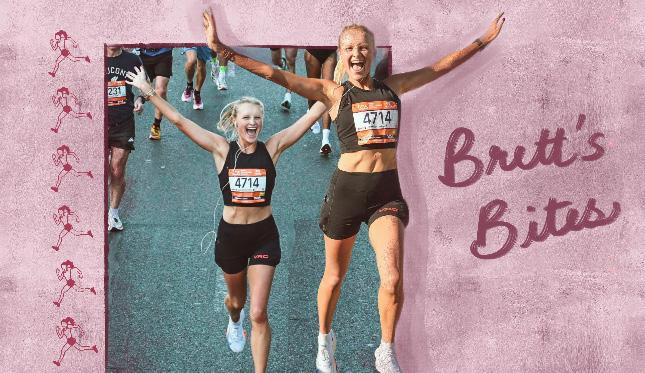
B y N icole c har Bit Heights Staff
Boston College-based band Caltha has quickly made a name for itself in the campus music scene, blending gritty guitar riffs with indie-rock sincerity.
After winning 2024’s BC’s Best and opening for Neon Trees at Modstock, the five-person group— Cormac Delaney, Michael McKane, Matthew Baldari, Owen Stannard, and Charlie Schulz—has played everywhere from basement house shows to benefit concerts.
Their latest project, Chicken Liver Testimony, featuring 10 tracks, showcases the band’s raw energy, lyrical wit, and growing musical depth, marking their territory as a rising force in the BC music scene.
The record explores themes ranging from self-exploration and relationships to nostalgia and the complexities of vulnerability. The project kicks off with “Fall Down,” a dynamic opener that immediately showcases Caltha’s rock sensibilities and guitar-driven sound. With its
layered riffs and urgent vocals, the track sets the tone for an album as emotionally charged as it is musically confident. The band’s most well-known track, “71,” succeeds the lead-off song and stands as an emotional centerpiece of the album.
“So if I fly too close to the sun / Would you pull me down? / I don’t know if my wings are made to melt / And it’s a long way down,” sings Delaney. In this new album, Caltha taps into themes of vulnerability, ambition, and the fear of failure.
The allusion to the Icarus myth adds depth, suggesting a tension between chasing dreams and the risk of self-destruction. Following each chorus on this track, a rush of powerful and raw guitar riffs crashes in, mirroring the emotions expressed in the lyrics and amplifying a sense of internal conflict.
Midway through the album, Caltha introduces their first collaboration with BC senior and accomplished vocalist Sofia Burke, MCAS ’25. Known for her stand -
out performance of “Bridge Over Troubled Water” alongside the Boston Pops at the 2024 Pops on the Heights concert, Burke brings a soulful depth to the track “Wash Away.”
Her harmonies with Delaney, Caltha’s lead singer, add a rich, emotive layer to the song’s chorus, which delves into themes of self-determination and the struggle to distance oneself from negativity.
Instrumentally, “Wash Away” continues Caltha’s exploration of complex arrangements, featuring intricate guitar work and a resonant bassline that underscores the song’s introspective spirit.
The penultimate track, “Dogbites,” marks a poignant shift in the album’s rhythm, embracing a slower, more emotional tone. The lyrics evoke a sense of lingering pain and unresolved emotions.
“You didn’t pass, and I walked home with dog bites on my hands / I spent the night alone / But if when you walk by and you think of me / Does it ever make you smile? / Won’t you call me up / See I’m
When asked about her training schedule and music, Chody said that she carefully crafts the designated marathon playlist but does not listen to it until the day of the race.
“I don’t use it until race day because I’m kind of superstitious like that,” Chody said. “It has a lot of the same songs that I train with, but it’s a specific curation, if you will.”
When it comes to fuel, marathoners have their preferences. Some swear by gels, others go for cubes. Chody’s favorite, however, is Honey Stinger Energy Chews. She eats every 30 minutes, an interval that might seem frequent to some, but, as she points out, the marathon standard is 30 grams of carbs every 30 minutes. And if you’re not a multitasker, don’t worry—just like Chody, you’ll get used to chewing and running at the same time.
Fuel aside, Chody also puts thought into how she moves between runs. Her cross-training routine varies, but often includes one lift session, one or two [solidcore] classes, and an occasional hot-yoga class at CorePower.
But there’s more to her routine than what happens on the mat or the road. That blend of content and athleticism raises a bigger question for many followers: Does sharing your training online change your relationship with the sport? For Chody, the answer is yes—in the best way.
And while she can’t run the miles for you, she can help you get in the zone. For those of you runners who aren’t yet “loyal biters”—as Chody often refers to her fans—here’s some advice: Set aside some time before your next training session and look up “Brett Chody” on Spotify. You’ll find all kinds of playlists to put on as the soundtrack of your next course.
She recalls watching the LA Marathon recently with a friend. As they stood cheering from the sidelines, some runners spotted her mid-race and shouted, “You’re the reason I’m running this!”
“The fact that I could inspire even one person to run and do something different, to challenge themselves and feel better about themselves, or to find an outlet that helps them mentally and emotionally, just means the world to me,” said Chody.
Looking ahead, Chody has her sights set on more travel and more run clubs, expanding them to be hosted across the country. But in the meantime, fans can expect marathon content to ramp back up in June as she starts training for the Chicago Marathon in October.
And who knows, maybe a Boston run club will be on the calendar for 2026—with Mile 21 as the meeting point. n
missing mine / I don’t know if you still care like I do,” sings Delaney.
The mention of “dog bites” could symbolize the physical manifestation of emotional wounds, suggesting that someone is grappling with both tangible and intangible scars. Themes of unreciprocated feelings, longing for connection, and the uncertainty of another’s affection are woven throughout the song.
The somber instrumentals mirror the vulnerability expressed in the lyrics, allowing the song’s emotional weight to resonate deeply with listeners.
Caltha’s Chicken Liver Testimony is more than just a debut. It’s a bold, emotionally resonant state -

ment from a band that’s already carved out a distinct voice in the BC music scene. With its blend of raw instrumentation, lyrical introspection, and collaborative depth, the album captures the essence of youthful exploration.
Whether you’re a longtime follower or a new listener, this record offers a compelling glimpse into the band’s evolving artistry and promises a bright future ahead.and collaborations are sure to be thoroughly entertaining for the Mile 21 crowd. And who knows, maybe BC students will be rewarded with a well-deserved surprise performance from Doja Cat after a long school year. n
By Brett Lundgren Heights Staff
Sunday’s game between BosNotre Dame Boston College 3 4 ton College baseball and Notre Dame was more than just another matchup. It was a series-deciding, rivalry matchup—a recipe for excitement.
The game, and especially how it ended, lived up to that expectation for a thriller.
In the final tilt of a three-game series, BC (17–18, 7–11 Atlantic Coast) beat Notre Dame (16–17, 4–14) 4–3 in walk-off fashion to take the series after the teams split Friday’s doubleheader.
“Just being able to play in tight games, and being able to make plays and make pitches in tight games, I actually think … builds more confidence than just a blowout,” BC head coach Todd Interdonato said.
“Looking at, holistically, a 4–1 week, that’s really what’s most important.”
The Irish looked to make a splash in the top of the first frame with a knock off Davis Johnson’s bat.
But it was tracked down by BC left-fielder Colin Larson at the wall, ending the inning with one runner stranded on base.
The Irish’s bats caught fire in the top of the second, however.
They got their first hit of the game
in the second at-bat of the inning off a Connor Hincks bunt single.
Hincks ended up recording the game’s first run, thanks to an RBI single from Nick DeMarco through the left side of the infield.
Leadoff hitter Jared Zimbardo’s RBI single immediately after brought home one more run before the inning came to a close.
In the Eagles’ first at-bat of the second inning, Larson blasted his first home run as an Eagle over the
change from BC.
As the first pitcher out of the bullpen, junior John Kwiatkowski came in for Kyle Kipp and threw two strikeouts with two runners in scoring position to get the Eagles out of the third-inning jam.
“He threw a slider for a strike, and throwing an off-speed pitch for a strikeout out of the bullpen is so important, and that’s what he was able to do,” Interdonato said.
Another bright spot on the Ea-
In the fifth inning, the Irish hit a fly ball into the helping wind.
But the ball and the play ended in Larson’s glove at the left-field warning track.
Just like in the first inning, he extinguished any threat of a runner in scoring position.
During the bottom of the fifth, the tail end of the Eagles’ lineup found a spark.
Vince Cimini started the action with a triple to right field with one
brought in freshman Oisin Lee, who faced Kyle Wolff and pitched an inning-ending strikeout. BC trailed 3–2.
One inning later, the Eagles put the pressure on again.
After a two-out single from Sam McNulty, Cimini blasted a double to left-center field that allowed McNulty to score from first and knot up the game 3–3.
In the top of the ninth, with the game still tied, the Irish put two

a pitching
But a huge strikeout from senior right-hander Eric Schroeder marked the end of the inning.
Suddenly, BC found itself with a chance to win the game in the bottom
That’s exactly what the Eagles did. McNulty got to second base after a leadoff single and subsequent
After a sacrifice bunt from Cimini moved McNulty to third, pinch-hitter Gunnar Johnson came into the
On the first pitch Johnson faced, he hit a walk-off single that soared over the center fielder’s head, allowing McNulty to make his way through home plate and give the Eagles a
A sea of blue-and-yellow jerseys flooded the field as BC captured a Holy War victory in dramatic
By SeBBy FitzgeraLd Asst. Sports Editor
The Holy War is a long-standing rivalry between two Catholic Notre Dame Boston College 5 6 foes—Boston College and Notre Dame—extending across all four major sports: football, basketball, hockey, and baseball.
The Eagles know wins don’t come easy when these games roll around. But that mindset hasn’t seemed to shift any narratives around BC and Notre Dame’s rivalry recently.
BC had yet to win a Holy War game in the 2024–25 season, and its last came on the hardwood in January 2024.
This time around, in a match up between the Irish and BC base ball, the Eagles weren’t let off easy, as Notre Dame quickly made its rivalry dominance known in the first inning of Friday evening’s matchup.
But a dominant first was all the Irish had to offer.
After giving up a five-run first inning, the Eagles (16–18, 6–11 Atlantic Coast) battled back with six unanswered runs to climb out of a hole and win the second game of Friday’s doubleheader 6–5 over Notre Dame (16–16, 4–13).
“We thought [Peter Schaefer] was a good matchup for them,” BC head coach Todd Interdonato said. “We thought, you know, that was the right guy to run out there, and Pete just, you know, he just struggled, right? Wasn’t missing by much, but wasn’t throwing enough strikes.”
Schaefer was sent back to the dugout soon after initially coming out of it in the first. The right-
hander graduate recorded just one out while allowing four runs on three hits.
Jared Zimbardo led off with a single and followed it up by stealing second. Three consecutive walks and 18 pitches later, the Fighting Irish crossed the plate for the first time in the game, but they weren’t done there.
Schaefer got his first and only out with a strikeout, but an RBI single from Connor Hincks and a two-RBI double from Estevan Moreno scored three more for Notre Dame.
Interdonato had seen enough and sent Tyler Mudd in—an adjustment which eventually proved to be a bright spot from the game.
A sacrifice fly scored Notre Dame’s fifth run, but Mudd only
Vince Cimini’s lead-off double and advancement to third base on a groundout got Fox pulled as DJ Helwig took the mound. The pressure was on Notre Dame.
A passed ball brought Cimini home and the score to 5–2, and Ragsdale’s triple two batters later brought some more hope. Jack Toomey’s pop-out, however, put an end to BC’s attempt at a momentum swing. But the Eagles didn’t let up there.
Two innings later and with Helwig still on the mound, McNulty began a rally with a walk, and Cimini singled to right the next at-bat.
Jace Roossien entered as a pinch hitter for Beck Milner and did his job to perfection—his bunt single set up a bases-loaded situation for Patrick Roche, who rocketed a
Roossien home to tie the game at 5–5.
Then, after Jacob Burnham and Joey Ryan posted scoreless sixth, seventh, and eighth innings for BC, the Eagles had all the momentum to snag their first lead of the game—and they did just that.
Adam Magpoc entered scoring position by stealing second after hitting a one-out single in the bottom of the eighth. Then, Colin Larson’s RBI double down the leftfield line finally gave BC the lead it so desperately needed.
“Larson getting that ball and putting a good swing on and keeping it fair—really cool to see a firstyear kid do that,” Interdonato said.
Karl Meyer sealed the emphatic comeback win for BC in a 1-2-3 outing, earning BC a split in
lineup twice. He could have gone out and faced the nine-hole.”
The Eagles applied pressure in the bottom of the second, putting runners on first and second behind Wolff and Cimini’s singles, but a fielder’s choice put the inning to a close.
The game stayed knotted at 0–0 until the sixth inning as Notre Dame’s Jack Radel pitched for 6.1 innings and only allowed five hits and one walk.
Meanwhile, JD Ogden was Colarusso’s successor. He only faced three batters in the fifth inning, thanks to a double play that rendered Zimbardo’s single meaningless. But the sixth inning was not as kind to Ogden.

in that span. Fox’s fifth inning didn’t last long, though.
to fall off,” Interdonato said about Colarusso’s outing. “He was one batter away from going through the
After a hit-by-pitch and a bunt single to start the inning, a sacrifice bunt put runners on second and third for the Irish. A sacrifice fly and a passed ball scored both threats and gave Notre Dame a late cushion.
Karl Meyer completed the final 2.1 innings, only conceding one hit and giving up zero runs.
BC’s offense struggled, though. The Eagles did not register a hit in three straight innings before smacking two singles in the seventh and eighth. The ninth inning didn’t see much success either.
Toomey led off the final frame with a single, and Magpoc moved him to second base with his single following Wolff’s strikeout.
After Larson reached on a fielder’s choice, Cimini was the Eagles’ last hope. But a three-pitch strikeout in Cimini’s at-bat put this one in the books.
“It wasn’t like we pitched poorly after that, it was just kind of … the misplays on the field,” Interdonato said. n
By DaviD PEREgosky Heights Staff
With the series tied 1–1 after Boston College softball split its Friday doubleheader with conference opponent Louisville, both teams entered Saturday’s game hungry for a series-clinching win.
Despite posting their highest-scoring game of the season, however, the Eagles exited Saturday’s game with a loss, moving them to 4–11 in ACC play and handing BC yet another conference series defeat.
Although the Eagles went down big early, as a 10–2 Louisville lead loomed over their heads after the top of the third, they rallied in the latter half of the game, outscoring the Cardinals 11–4.
Jordan Stephens posted an impressive showing at the plate, going 4 of 5 with a home run and a triple, posting six RBIs to account for nearly half of BC’s 13 runs.
The Cardinals were successful at the plate too, though.
They posted five extra-base hits, four of which were doubles, ultimately allowing them to edge out a win and clinch the series.
Bailey Kendziorski’s outing in the second half of Friday’s doubleheader started efficiently, as she posted a 1-2-3 inning that ended with a swinging strikeout from Char Lorenz.
Though it seemed the Cardinals would execute a similarly quick inning on defense, as a leadoff five-pitch strikeout against Emma Jackson suggested, Gator Robinson had other ideas.
She sent a solo shot over the left-field wall, giving BC an early edge.
Despite the early lead, though, the Eagles ultimately fell to Louisville 5–2 due to a quiet offensive showing.
“We hit some balls hard,” BC head coach Amy Kvilhaug said. “We have to cut back on [strikeouts], and we have to have better plate discipline.”
While the Eagles threatened to deal more damage in the opening frame, getting runners at first and second with two outs, Louisville
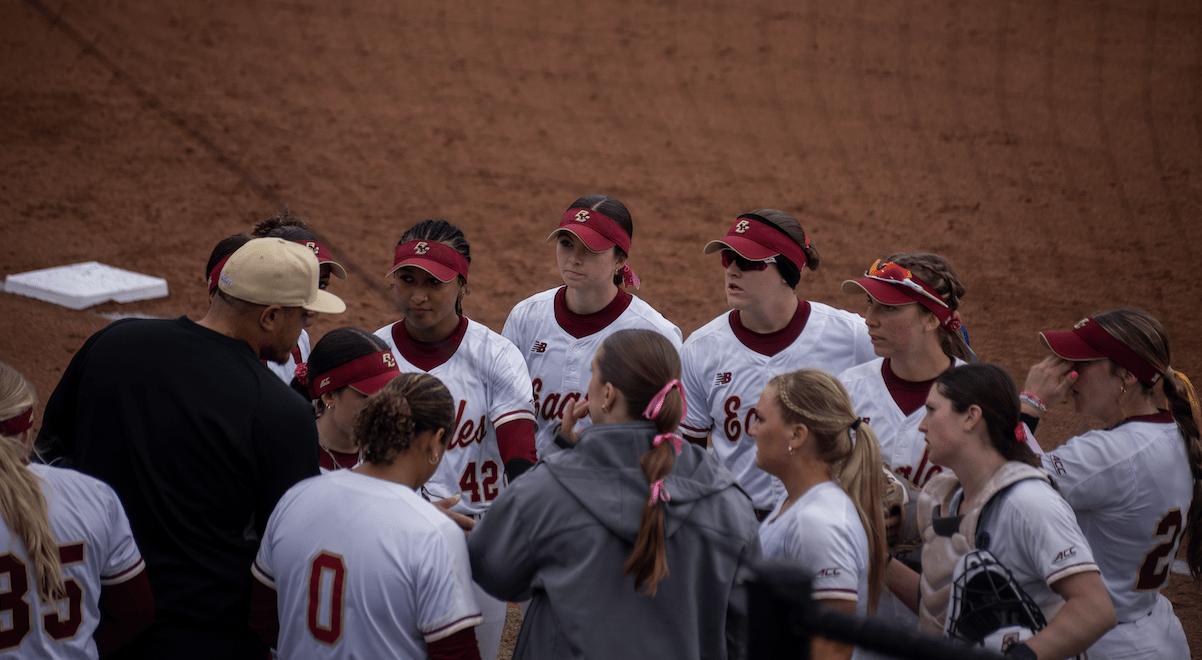
starting pitcher Brooke Gray used a timely fielder’s choice on a ball from Adriana Martinez to keep the score 1–0 after the first.
The Cardinals were able to make some contact on Kendziorski’s pitches in the top of the second, getting two runners on base off two singles.
But a quick heads-up catch at third from Janis Espinoza prevented any damage to BC’s lead.
Gray had a strong showing in the bottom of the second for Louisville, shutting down the BC offense and allowing only one baserunner by way of a walk to maintain the Cardinals’ one-run deficit.
In what was becoming a pitching duel, Kendziorski followed up Gray’s performance with her second 1-2-3 inning of the game, again ending it with a swinging strikeout.
Not wanting to be outdone, Gray answered Kendziorski with a 1-2-3 inning of her own to sustain the 1–0 score heading into the fourth.
Like clockwork, Kendziorski again shut down the Cardinal offense for her third 1-2-3 inning of the game.
Finally, Martinez broke the offensive stalemate for both sides in the bottom of the fourth, as she sent a ball into the right-centerfield gap to reach first with one out.
Gray remained seemingly unfazed, though.
The Eagles couldn’t get anything else going on offense, extending the scoring drought for both squads.
“We haven’t faced a lefty throwing 57 miles an hour yet this season,” Kvilhaug said “So, I think it’s just a matter of adjusting.”
Louisville finally broke through in the top of the fifth, as a single into left field from Jac Hasty scored Bri Despines from second to tie the game 1–1 with no outs on the board.
The draw wouldn’t last long, however.
In the very next at-bat, Taylor Monroe hit a two-RBI homer to give Louisville its first lead of the game.
“[Kendziorski] typically doesn’t fall behind as much as she did today,” Kvilhaug said. “But she gave us everything she had.”
Kendziorski settled in and got the next three batters out in quick succession to limit the damage and send the game into the bottom of the fifth with a two-run deficit for the Eagles.
In the circle, Gray was unrelenting. A one-out single from Jackson gave BC hope of some offensive success, but consecutive flyouts from Robinson and Hannah Slike got the Cardinals out of the inning unscathed.
Kendziorski loaded the bases in the top of the sixth by walking a batter and hitting another with a pitch. But a timely flyout to center field provided the third out of the inning and kept the game at 3–1.
In desperate need of life on offense, Stephens led off the bottom of the sixth inning for the Eagles with a sharp single into left field.
Once again, Gray showed no mercy to the BC offense, getting the next three batters out, two of whom she struck out, to suffocate BC’s hopes of cutting into the two-run advantage held by the Cardinals.
Louisville poured it on in the top of the seventh, scoring two runs off a double into left field that went over the head of Zoe Hines, leading Kvilhaug to pull Kendziorski with one out left.
In relief, Gabriella Aughton secured the final out of the top of the seventh inning, getting the Eagles up to bat in need of a substantial offensive explosion to secure what could have been a series-clinching win over the Cardinals.
With one out in the bottom of the seventh, Abby Ptak sent her first career home run over the left-field wall to cut into the deficit, making the score 5–2 with lots of work still to be done.
This score would stand,
By Emily RoBERgE Assoc. Sports Editor
After being selected by Boston College lacrosse to wear the No. 19
Welles Crowther jersey in the Red Bandanna Game, Elizabeth Kirk made just as much of an impact, if not more, during her Senior Day against No. 11 Virginia.
With 3:12 left in the matchup, Kirk scored her second goal of the season off an Emma LoPinto behindthe-back feed.
But she wasn’t done yet. A little less than a minute and a half later, off a Shea Baker draw control and Mckenna Davis assist, Kirk notched her third goal of the season by juking her defender and sending the shot into the upper-right-hand corner of UVA’s net, making the crowd go wild.
“How amazing is that?” BC head coach Acacia Walker-Weinstein said. “Elizabeth is just one of those players
that everyone wants to see her do well, and when she has the ball on the field and success like that, she is incredible, and I am really happy for her.”
Despite losing its first game of the season against No. 1 North Carolina last weekend, No. 2 BC (14–1, 7–1 Atlantic Coast) did what they usually do against opponents—win and win big. Although they started the matchup neck and neck with the Cavaliers (10–5, 4–4), the Eagles coasted past UVA with a 24–11 win in Alumni Stadium.
The Eagles knew exactly what needed to be done on a rainy and snowy Saturday in Chestnut Hill.
“After UNC, our motto was to respond, and I think every single one of us our goal was to play together and to play for each other,” Rachel Clark said. “We think we beat ourselves against UNC. We didn’t play BC lacrosse. We had a lot to learn, but again, our goal was to respond. We
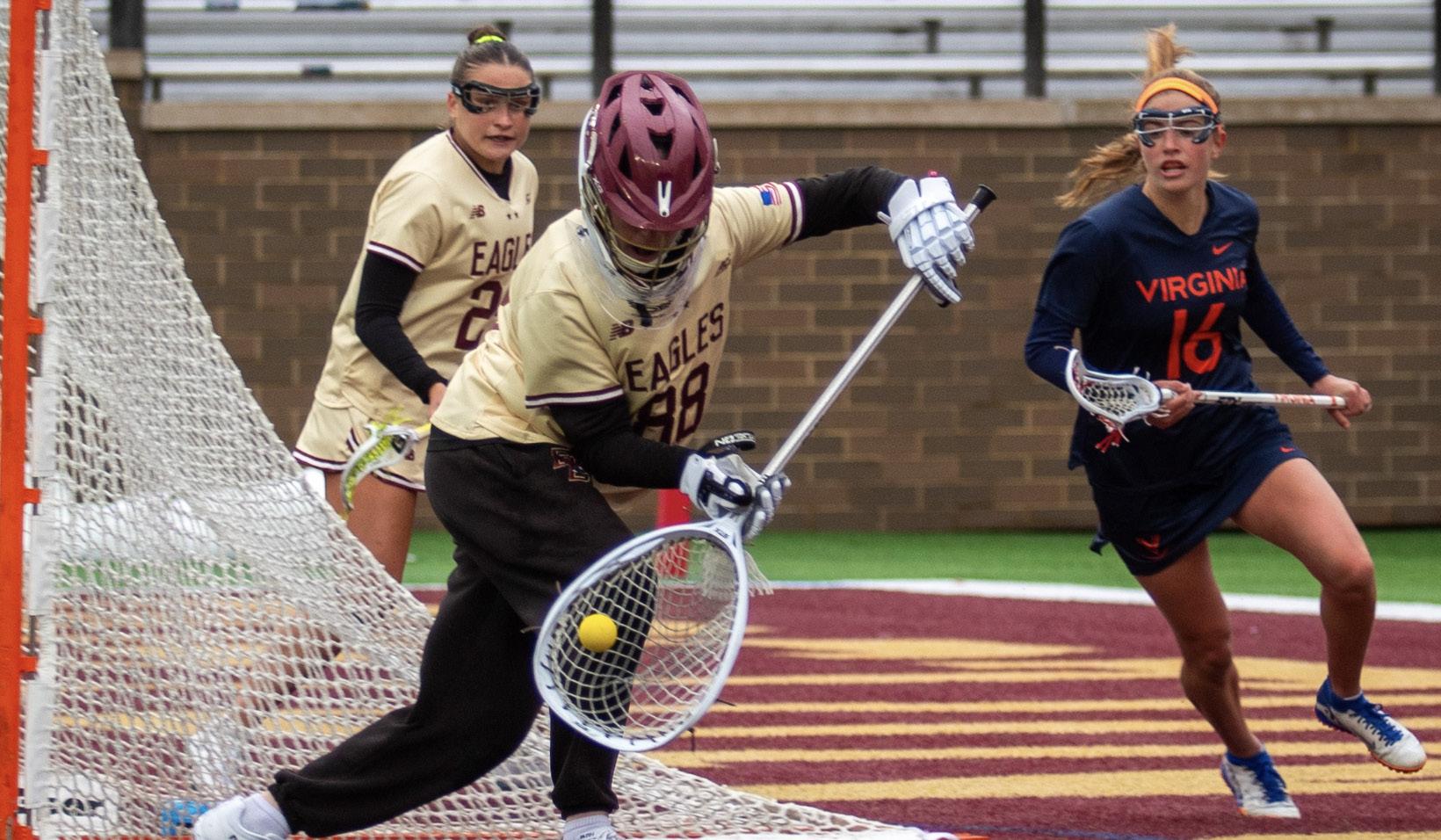
didn’t think our preparation was good enough going into UNC, so we just wanted to respond.”
BC did just that.
It only took Maria Themelis 18 seconds to put the first points on the board, marking her 14th goal of the season off a Davis assist.
Davis, who recorded nine assists in the matchup, tied a BC assist record, propelling her offense to a smooth-sailing victory.
Less than two minutes later, LoPinto tallied her 51st goal of the season off another Davis assist, rattling a shot through the legs of Mel Josephson, who couldn’t come up with the save.
BC’s offensive showing only continued as the Eagles maintained a 6–3 lead going into the second frame.
During the second period, though, the performance was rather sloppy for BC, as UVA inched back from down three goals to only being down by one. Though UVA diminished the Eagles’ lead to 7–6, that was the last time UVA’s offense had any footing.
After the first half, where the Eagles led 10–6, it was the BC show.
“I thought our performance was well-rounded defensively, in the midfield, and I was just really happy,” Walker-Weinstein said. “I just think they prepared really well, and it reflected in the game.”
Beginning the third quarter up 10–6, BC extended its lead to an eightgoal edge by the end of the frame,
featuring five different goal scorers. What defined the Eagles’ performance was an aspect of the game that received less attention, though: the draw control.
Junior Abbey Herod had a career-high 13 draw controls against UVA, allowing the Eagles’ offense to dominate nearly every aspect of the matchup.
“Abbey has just been really dialed in,” Walker-Weinstein said. “I think she is really demonstrating a lot of focus and a lot of hard work, and I think she is getting better, which is really cool because that’s what we want to see at this point, we don’t want to see anyone plateau, and I am really happy with her. She’s getting even better, and I think that is dangerous and good for our team.”
The final frame was when BC really showcased the entirety of its senior class’ talent. Five of BC’s seven goals in the last quarter came from seniors.
And that didn’t come without some emotions from WalkerWeinstein.
“This group, all of them, the kids I have known since they were young, and over the years bringing in Emma and Rachel and bringing in Mia, Morgan, and Maria, this is a really special group,” Walker-Weinstein said. “I love that they have the personality and hearts to blend all different groups coming in at all different times and mentoring the team to such an amazing season so far.” n
though, as a Robinson pop-up in foul territory ended the Eagles’ hopes of a walk-off victory in the second game of their Friday doubleheader.
“You just go out and you play softball, you have fun, you execute,” Kvilhaug said. “We’ve prepared and we’re ready.”
BC scored its first run of the weekend in the bottom of the first inning in the first game of Friday’s doubleheader when a wild pitch allowed Jackson to score from third.
That put the Eagles up 1–0 over Louisville, giving them their first lead of the ACC foes’ weekend series.
This would be the extent of BC’s scoring, though, until a run from Robinson on a fielder’s choice and a Martinez sacrifice fly scored two more runs for BC in the bottom of the fifth.
Those two runs were ultimately enough for the Eagles to secure a 3–1 victory, thanks in large part to a strong pitching performance from Kelly Colleran.
Colleran posted a complete performance, conceding only one run, which came off two triples in the top of the fourth.
Colleran allowed only three runners to reach base over the span of her seven-inning outing, helping BC to what turned out to be its only win of the weekend. n
